#three poems for benjamin walter
Text








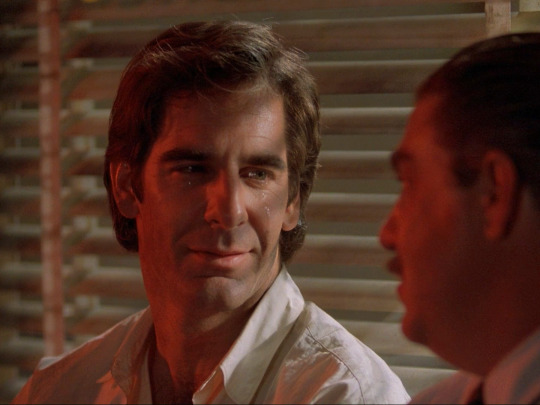

samuel beckett as paul klee's angelus novus (new angel; 1920)
+ laurie anderson, the dream before (1989)
+ walter benjamin, theses on the philosophy of history (early 1940s)
+ + s.d. chrostowka, angelus novus, angst of history (2012)
+ gershom scholem, Gruß vom Angelus (greetings from the angelus) (1921)
#quantum leap#(<- putting this in tags first so it actually shows up lol)#*folds hands* so. i was reading this paper on quantum leap and about the way history is portrayed in fiction#and the paper actually began with that laurie anderson lyric....... and so... it all kind of spun off from there#also there are LOT of translations of Gruß vom Angelus btw. i picked that one because i like the second line being italicized#the link goes to a slightly different translation of the full poem that i like the most as a whole (as it relates to ql of course)#also i would really recommend learning abt angelus novus (the art piece) bc there's a lot of history behind it#it only survived the holocaust/wwii because of walter benjamin (who tragically did not survive himself)#and Gruß vom Angelus was written for benjamin specifically about it. like all three of those points are connected#anyway ummm quantum leap. right. well this is my post about how sam is now an angel to me mentally i hope everyone likes it#i was gonna say stuff about the individual screenshots but you know what... i don't wanna. interpret them however you want. that's art babe#ql#oc
28 notes
·
View notes
Photo









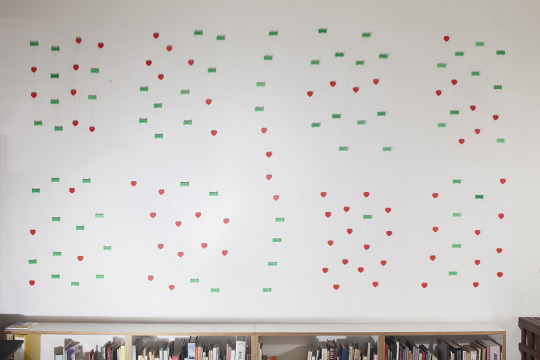
IMAGES OF THE WORD
solo exhibition
20 Nov.–Dec. 2014, Un Cabinet D’Amateur / Olivier Boissiere, Sofia
Four series by Svetlana Mircheva based upon chance meetings with things and words From rebus to cosmic constellations, to twisted slogans and computer explorations a short sampling of possible intrusions of the visual arts in the infinite world of language.
Works in the exhibition:
4 Rebus collages on canvas, series
--Fly me to the moon
--At 11 o’clock put everything in the blue pot
--Cry me a river
--Menuetto in G major
For Laika with love, series, 9 calligrams, polymer clay biscuits
Ads for happy days, series, 3 twisted slogans, 2 Glagolitic sentences
--You've got questions, we've got mountain
--How many licks does it take to get to the center of a sun?
--Non stop cri ckets
--Me, knowing the letters, I speak / Glagolitic
--Speak the word strongly / Glagolitic
Make pages, 1-15, series, thesaurus for the word "make"
Make believe, thesaurus for the word "make"
Good morning, 1&2, ready made
Possible exhibitions, model 7
RANDOM, CHANCE, BLIND DATE, SERENDIPITY
“langage=jeu galant”. Marcel Duchamp
Once upon a time, there was a flâneur. Baudelaire followed him strolling the city leisurely both distracted and attentive to the new world (it would become brave later), looking for modernity. A viewer/voyeur, he would note the remarkable in the environment of his contemporaries, the spread of commercial activities as a consequence of the industrial revolution and the raise of consumerism. The flâneur attitude marked a significant shift in the points of views upon the world. Shop-windows became familiar scenes where artists would dig for inspiration. The cubist collage and Duchamp’s ready-made replaced the representation of the object by the object itself incorporated into assemblages exposed to language that would become the rule at mid-century. Walter Benjamin haunted the Paris “passages”, the Surrealists the flea market of Saint-Ouen looking for bizarre objects of undetermined functions and forms, craving for close encounters of the third kind , expecting surprise ( “soup-rice” as the Marx brothers had put it )
“One does not do poetry with ideas, one does poetry with words”1. Mallarmé said. He must have foreseen that poetry could become image by means of “a throw of the dice”. Freeing words from one another, dispersing them on the page opens new interpretations as well as a disconcerting design. Are they pure coincidence or an effect of the Zeitgeist? Mallarme’s poem might look as a prelude to the re-introduction of the word in visuals arts. From Picasso’s first cubic collages to Schwitters’ Merzbau, to Saul Steinberg’s rebus and Rauschenberg’s , then “Conceptual’ and Art language, Kossuth, Lawrence Wiener, then Bruuuuuuuce Nauman, Ed Ruscha et al, words, sentences, aphorisms did invade the art field. An art work could both express and enounce?
The computer age has generated a new version of the flâneur, the “geek” zooming and zapping on the freeways of information. Exit the street and the city. The world has turned global and the Net its cosmic echo. An all-over set of information both text and imagery has become available at fingertip distance. The somewhat naive first fans of cybernetics in the late 60s prophesized then the advent of some new Leonardo, Picasso or other artist genius who would take up the new medium and generate new masterworks. This has not happened (yet). But the amazing field of the Web providing for all kind of opportunities of criss- cross and short cuts is currently being explored. Wait and see…
Horace Walpole coined the name “serendipity”2 from an indo-arabian old legend where the three princes of Serendip described a lost camel that they had never seen through the traces and indexes which they had noticed on the road. Serendipity was defined as discovering by chance something that one was not looking for, or the art to take notice to the surprising and give it a pertinent interpretation. It was thus chance + sagacity. The word had a discreet carrier at first until it reached the scientific domain with the discovery of the penicillin (a fortuitous accident, according to Fleming) or Albert Hoffmann’s one of LSD. Even Isaac Newton and his apple were called in. It became an argument for free versus applied research. In the art field, it sounds like a fact, No usefulness is expected. Free imagination, innovation and fantasy are supposed to be the rules of the game. Serendipity is supposed to pop up without notice. “The stupid call these strikings of the thought “chance” without thinking that chance never occurs to the dunces.”3
Svetlana Mircheva is the heiress of all the above. She walks the city, collects abandoned objects, bits and pieces, sheets of left over papers, fragments of newspapers (preferably old) photographs of loves forgotten, rags of faded materials evocative of lives unknown, memories anonymous. The artist reinserts them in comic strips, little tales to be deciphered, telescoping images and words (image as text, text as image) in poetic collages in the form of rebus, those “compositions that operate this great marriage of letter and drawing which has always haunted the baroque artists.”4
Mircheva’s attention to shop windows might be triggered by petty trivial domains. Exploring pet shops she has spotted a variety of dog food, biscuits wearing unexpected words suggesting pet loves …She has used them to design candid canine calligrams, nursery rimes whistling little tunes, pretty constellations, as many tributes to Laika, Pschyolka, Mushka and other moon dogs heroes of the first Sputnik age. Ironic compassion? Love thy dog as thyself?
The interactive aspect of the computer can take (at least) two forms: communication with brothers/sisters internauts or direct dialog with the Machine, as it offers help/services to user/client. Mircheva contacted once by curiosity programs which given a name of your firm + keyword to your activity would deliver the right slogan for your advertising. The tests Mircheva did rapidly proved deceptive, either irrelevant or conventional. But a little twist on a sentence could make them funny on the verge of the absurd. So… Coincidently Mircheva landed on the glagolitic site. Cyril and Method had elaborated an alphabet before the Cyrillic. In their devotion, they had followed up with three sentences using each letter as a key to a word all to the glory of God. A sublime early use of sacred advertising!
Following up with her “mistakes” Mircheva has bumped into new intriguing incidents. A A4 found in a paper basket had all the visual seductions of the “conceptual” art of the 60s. The content, an exploration of the keyword “make” proved most serious and hilarious. A further research led (with the help of New York curator friend Eriola Pira) to a million words thesaurus accumulated by a very serious university department in Providence, RI, on the possibilities of computers in the field of language in the early 60s. With “Make” the viewer is invited to pursue with the game. Infinitely. “Language is a virus from the outer space.”5
Certainly serendipitous Svetlana Mircheva is not fooled by the process. She is well aware that the haphazard character of serendipity cannot ever constitute a method, only a state of mind. Told about the story of the three princes of Serendip, Mircheva had but a brief comment: “there is no normal camel” she said. Think of it.
Olivier Boissiere
1 Stephane Mallarmé “Un coup de dés jamais n’abolira le hasard” in Cosmopolis Paris 1897
2 Sylvie Catellin “Serendipité, du conte au concept” Seuil Paris 2014
3 Balzac “Theorie de la démarche” L’Europe litteraire 1833, La Pleiade 1981 tome XXII
4 Roland Barthes about Saul Steinberg in “All except you”. Repères. Galerie Maeght. 1983. See also Rosalind Krauss “Rauschenberg and the Materialized Image” in “The originality of the Avant Garde and other modernist myths” The MIT Press Cambridge Mass. 1985
5 William Burroughs
CATALOG ONLINE
0 notes
Photo

Kathleen Graber, The Eternal City: Poems
#kathleen graber#the eternal city: poems#three poems for benjamin walter#loggia#words#poetry#typography#the great wound#xx#but we are ghosts only#hauntings
20K notes
·
View notes
Photo

Now that the “dunk” cycle has passed, I do have something to say about this viral Tweet. First, like all sublimely stupid remarks, it passes into brilliance. “Allegory of what” is a reasonable and even eloquent characterization—it would be a good title for an essay—putting in the vernacular Walter Benjamin’s famous description of Kafka’s works as Haggadah without Halachah—i.e., Talmudic illustrations of the law sans the law itself. What kind of sensibility does this offend? Well, let’s not defang the modernists—it honestly might irritate anyone. I myself have a somewhat checkered relationship with Kafka; I like him short, in aphorisms and prose-poems, and I think his masterpiece might be “A Hunger Artist,” an absolutely perfect story, which I don’t quite understand, except that it’s about me and my experiences, which I don’t understand either. The longer pieces, especially the novels, don’t have the same power, because the oneiric style feels forced and willful when extended. (I should say I’ve read a lot of Kafka but not all and never systematically, just in fits and starts between my teen years and today; my major omission is The Castle.)
Still, Dawkins’s remark also illuminates a larger phenomenon. I saw the other day a social-media inquiry, with what agenda I don’t know, about whether there was some continuity between Dawkins’s New Atheist movement and today’s wokeness. The answer is the opposite: official anti-wokeness, the Intellectual Dark Web, descends from New Atheism. But they share a sensibility, since both New Atheism and wokeness can be described, maybe unfairly but not simply in jest, as puritan sects. And what does the puritan want from a text? Governor Winthrop explains:
At Watertown there was (in the view of divers witnesses) a great combat between a mouse and a snake; and after a long fight, the mouse prevailed and killed the snake. The pastor of Boston, Mr. Wilson, a very sincere, holy man, hearing of it, gave this interpretation: That the snake was the devil; the mouse was a poor contemptible people, which God had brought hither, which should overcome Satan here, and dispossess him of his Kingdom.
The interpretation is so insistent and indisputable that the allegorical surface, here nature itself, is wholly dispensable. The New Atheist and the woke want a text the opposite of Kafka’s, one whose narrative, drama, style, and imagery are so morally legible that no “wrong” interpretation is even imaginable. Hence to the New Atheist, anything that calls for interpretation is irrational, while to the woke it’s elitist or crypto-fascist. American literature is the struggle of the puritan interpretive impulse toward complex artistic expression. This often results in amputated allegories, which is why Hawthorne and Melville often sound like Kafka.
Yet I’m sure I go too far. “Franz Kafka or Thomas Mann?” Georg Lukács rhetorically wondered—for the communist critic, the right answer was Mann, since he was (supposedly) a realist. David Mikics, reviewing a re-release of Mann’s Reflections of a Nonpolitical Man (which I’ve never read), reminds us of how Mann caught the character of the totalizing puritan by semi-caricaturing Lukács himself as Naphta in The Magic Mountain. Mann showed Naphta as a Jewish-turned-Jesuit Hegelian nihilist, which is to say that all traditions harbor their own oversimplifications. They always beckon us into the purity spiral. For nonpolitical Mann, that stolid German burgher and paterfamilias always about to melt into the Mediterranean, purity’s opposite is art:
Mann knew in Reflections that individual freedom, which he identified with the writer’s talent for playing with ideas, must stand against all political demands. It is on behalf of that life-giving freedom that Mann celebrates “art’s lively ambiguity, its deep lack of commitment, its intellectual freedom ... someone who is used to creating art, never takes spiritual and intellectual things completely seriously, for his job has always been rather to treat them as material and as playthings, to represent points of view, to deal in dialectics, always letting the one who is speaking at the time be right.”
The higher playfulness that Mann espouses in these sentences from Reflections perfectly suits his dazzling, many-faceted Magic Mountain, so different from today’s prizewinning novels, which present uplifting lessons endorsed by the socially conscious author and his or her tenure committee. In Mann, each character is right when he or she speaks, and the whole revolves in crystal.
A serious way of not taking things seriously—all those italics!—but still heartening. Mikics argues for a continuity between the early Mann and the later, though the author’s career is more customarily seen as a consistent drift from right to left. Considering Mann’s middle-period novella, Mario and the Magician, which exposes fascism in a wholly fascist way, and his almost unbearably excellent late masterpiece Doctor Faustus, a novel that criticizes the daemonic work of a genius while also being the daemonic work of a genius, he may be right.
I am more interested in the irony that everything I’ve written above would have been considered looney-left academic gibberish at the peak of neoconservative hegemony and New Atheist ascendancy about 15 years ago, whereas now it is considered reactionary obscurantism. It’s no sign of virtue alone to be attacked by both the left and the right—three people can be wrong at once—but to be scorned by the puritans of all creeds for not writing stories with obvious morals probably means an author is onto something. To quote Lukács from before he joined the Party, “Art always says ‘And yet!’ to life.”
#franz kafka#thomas mann#georg lukács#richard dawkins#literary criticism#literary theory#literature#david mikics
10 notes
·
View notes
Text
A Critical Essay on the Life & Poetry of William Wordsworth
With respect to 'The Prelude' & the 'Lyrical Ballads'

Portrait of the English Romantic poet William Wordsworth by Benjamin Haydon.
"You have given me praise for having reflected faithfully in my poems the feelings of human nature. I would fain hope that I have done so.
But a great poet ought to do more than this; he ought, to a certain degree, to rectify men’s feelings, to give them new compositions of feeling, to render their feelings more sane, pure, and permanent; in short, more consonant to Nature, that is, to eternal Nature, and the great moving spirit of things."
Wordsworth wrote this in a letter, in response, to his friend, John Wilson on the 7th of June 1802, thanking him for his heartiest congratulations on the success of his Lyrical Ballads and in the process reflected on the ideas of his poetical abilities and ambitions. Indeed, Wordsworth was a poet far ahead of his times, creating over the span of eighty years a colossal magnitude of poetic works which have become a part of the very fabric of the English language and literature.
Like many of his contemporaries, Wordsworth was influenced acutely by the historic event of the French Revolution, of which he was not only an observer but an active participant and supporter. But before delving too deep into his works and genius we must understand something about his life and childhood, without which, one cannot think of understanding his poetry let alone Wordsworth himself.

Young Wordsworth in 1798, in Town End, Grasmere.
WILLIAM WORDSWORTH was born in the Lake District in April 1770 and died there eighty years later on 23 April 1850. He had three brothers and a sister, Dorothy, to whom throughout his life he was especially close. When she was six and he was nearly eight, their mother died. Dorothy was sent away to be brought up by relatives and a year later William was sent to Hawkshead Grammar School.
Wordsworth was cared for in lodgings and led a life of exceptional freedom, roving over the fells that surrounded the village. The death of his father broke in on this happiness when he was thirteen, but did not halt the education through nature that complemented his Hawkshead studies and became the theme of his poetry.
As an undergraduate at Cambridge, Wordsworth traveled (experiencing the French Revolution at first hand) and wrote poetry. His twenties were spent as a wanderer, in France, Switzerland, Wales, London, the Lakes, Dorset, and Germany. In France, he fathered a child whom he did not meet until she was nine because of the War.
In 1794 he was reunited with Dorothy and met Coleridge, with whom he published Lyrical Ballads in 1798, and to whom he addressed The Prelude, his epic study of human consciousness. In the last days of the century, Wordsworth and Dorothy found a settled home at Dove Cottage, Grasmere. Here Wordsworth wrote much of his best-loved poetry, and Dorothy her famous Journals.
In 1802 Wordsworth married Dorothy’s closest friend, Mary Hutchinson. Gradually he established himself as the great poet of his age, a turning-point coming with the collected edition of 1815. From 1813 Wordsworth and his family lived at Rydal Mount in the neighboring valley to Grasmere. In 1843 he became the poet laureate.

A recent cover page of the 'Lyrical Ballads' by Wordsworth & Coleridge, which heralded the Romantic Age in English Literature.
Now, keeping this dynamic canvas of Wordsworth’s life in consciousness can begin to grasp the magnitude of his poetic genius. To begin with, we can say Wordsworth was a game-changer in the history of English poetry. By publishing, his epoch-making collection of poems, Lyrical Ballads, Wordsworth along with Coleridge heralded the Romantic Age of English poetry. On which Coleridge writes in chapter 14 of his book, Biographia Literaria, about Wordsworth and his romantic ideas thus:
"Mr. Wordsworth, on the other hand, was to propose to himself as his object, to give the charm of novelty to things of every day, and to excite a feeling analogous to the supernatural, by awakening the mind’s attention to the lethargy of custom, and directing it to the loveliness and the wonders of the world before us; an inexhaustible treasure, but for which, in consequence of the film of familiarity and selfish solicitude, we have eyes, yet see not, ears that hear not, and hearts that neither feel nor understand."
-Coleridge on Wordsworth, Biographia Literaria
And so we see that Wordsworth did exhibit all these themes and ideas repeatedly in his entire works. He takes as his subjects the poor, the old, and the outcast, for example in the poems ‘Goody Blake and Harry Gill’, Wordsworth talks about an old woman who has to steal firewood to survive the winter. His poem, ‘Her Eyes Are Wild’, about a vagrant woman suckling her child:
Suck, little babe, oh suck again,
It cools my blood, it cools my brain,
Thy lips I feel them, baby, they
Draw from my heart the pain away.
-from ‘Her Eyes Are Wild’
In ‘The Old Cumberland Beggar’, a beggar sits among ‘wild empty hills’ eating, and his ‘palsied hands’ scatter crumbs while the ‘small mountain birds’ surround him, waiting warily for their ‘destined meal’. In the popular poem, ‘The Idiot Boy’ a poor countrywoman, Betty Foy, is the mother of a disabled son who gets lost and spends a night in the open air. When she finds him he speaks wonderingly of the owls and the moon, without realizing what they are.
This was a major breakthrough in English poetry as Wordsworth brought to the poetic arena, the lives of the common people and this was huge because no one had ever made such people a subject of their poems before. Also new in Lyrical Ballads are poems about children and how adults fail to understand them.
In the poem, ‘Anecdote for Fathers’, a boy resists adult logic, and in ‘We Are Seven’, a small girl, whose brother has died, insists that he still counts as one of the family. Wordsworth’s belief in the superiority of childhood is expressed most challengingly in the ‘Immortality Ode’ written in 1802, where he remembers his early years.

A painting of the French Revolution of 1789, which ousted monarchy from France and had a big impact on Wordsworth and many intellectuals.
Through his selected works, written after the experiences of the French Revolution, one also comes to feel the sympathetic nature of Wordsworth towards the lowly and the poor. Like in The Prelude, he recalls, how a revolutionary friend pointed to an emaciated girl they met on a walk and declared:
'Tis against that
That we are fighting
In the ‘Residence in London’ book of the same poem, he remembers seeing a poor man with a sick child in his arms, and writes:
Bending over it,
As if he were afraid both of the sun,
And of the air which he had come to seek,
Eyed the poor babe with love unutterable
As for expressing the moods and settings of nature, Wordsworth is the unquestioned master, often and aptly called by many to be the poet of nature. One can even argue that no English poet expresses nature in its innate sensual beauty and spiritual entirety as Wordsworth.
What’s more interesting in Wordsworth’s portrayal of nature is that for him Nature is not just Mother Earth that needs to be expressed and captured in words but is much more than that. Like in the poem ‘Lines Written in Early Spring’, included in Lyrical Ballads, Wordsworth expresses the belief that nature is conscious as he writes:
'Tis my faith that every flower
Enjoys the air it breathes.’
Or the core Romantic belief that nature is a moral educator is stated with breath-taking simplicity in another Lyrical Ballads poem, ‘The Tables Turned’ where he writes:
One impulse from a vernal wood,
May teach you more of man,
Of moral evil and of good,
Than all the sages can.
In this regard one remembers a famous passage from The Prelude which gives an instance of Wordsworth expressing, nature acting as a moral guardian. The passage is about one summer evening when young Wordsworth takes a boat without its owner’s permission, and as he rows, he expresses:-
A huge peak, black and huge,
As if with voluntary power instinct,
Up reared its head
It seems to stride after him and, trembling, he returns the boat to where he found it. Even when not guilt-ridden, the boy Wordsworth in The Prelude is aware of nature as a living presence:
I heard among the solitary hills
Low breathings coming after me and sounds
Of indistinguishable motion, steps
Almost as silent as the turf they trod.
On Wordsworth’s poetic oeuvre, Walter Pater, a critic of Wordsworth’s time comments in his essay titled- Appreciations (1889) that Wordsworth to be the poet of ‘impassioned contemplation’ and in stressing both words equally, he got the balance exactly right. In his attempts to characterize the nature of the poetic or creative power, Wordsworth laid similar emphasis on impassioned seeing.
Perhaps, one can say, that the best encapsulation of Wordsworth's entire creative output has been written by none other than Wordsworth himself in the poem, ‘Glad sight wherever new with old’, written in 1842 when he was seventy-two. This poem points to almost everything that has been central to his long imaginative engagement with words and things. Wordsworth in it writes:
Glad sight wherever new with old
is joined through some dear home born tie;
The life of all that we behold
Depends upon that mystery.
Vain is the glory of the sky,
the beauty vain of field and grove
Unless, while with admiring eye
We gaze, we also learn to love.
Image Credits:- Pinterest & Google
References & Research:-
The Concise History of English literature by William Henry Hudson
The Routledge history of English literature
The Routledge Anthology of Poets on Poets
A little history of Poetry by John Carey
JASTOR Essays
Follow Me On Instagram
instagram
Up Next
Wanna Read More
#art#criticism#william wordsworth#dorothy#literature#poetry#love poem#artwork#essays#english homework#photography#books & libraries#naturepoems#romanticism#Instagram#english lit student#literary criticism#romantic quotes#romantic poetry#hopeful romantic#samuel taylor coleridge#penguin classics#ballad#lyric headers#lyric aesthetics#portrait#country music#english#buy online essays#essay paper writing services
17 notes
·
View notes
Text
All The Books I Read In 2020
Here she is! The full list of books I read in 2020. My goal was to read 52 books again this year, but once lockdown started I upped it to 100, and I ultimately surpassed even that goal!! I think reading is so important for my personal growth and mental health, so the last two years I have made reading a big priority in my life, and it is the best choice I could have made. This year especially, I found reading to be such a comfort and such a great tool for keeping the quarantine blues at bay. Here’s to all the books I read in 2020, and all the books I will read in 2021!
132 books, 44,531 pages, and a refreshed passion for learning and growth:
The Kite Runner- Khaled Hosseini (372 pgs) 4.5
A Discovery of Witches- Deborah Harkness (579 pgs) 2.75
The Call of the Wild and Selected Stories- Jack London (176 pgs) 4
I Wear The Black Hat -Chuck Klosterman (225 pgs) 3.75
Digital Fortress- Dan Brown (430 pgs) 3.75
Night Boat to Tangier- Kevin Barry (224 pgs) 2
The Chemist- Stephanie Meyer (518 pgs) 3
Find Me- Andre Aciman (272 pgs) 3.5
A Walk In The Woods- Bill Bryson (394 pgs) 4.5
Invisible Monsters- Chuck Palahniuk (304 pgs) 2.5
Underland, A Deep Time Journey- Robert MacFarlane (496 pgs) 3.25
The Dutch House -Ann Patchett (337 pgs) 5
Notes From a Small Island -Bill Bryson (324 pgs) 3.75
Home Work -Julie Andrews (560 pgs) 3.5
100 Essential Things You Didn’t Know About Maths and The Arts- John D. Barrow (320 pgs) 2.25
On the Road -Jack Kerouac (307 pgs) 3.5
Train Dreams -Denis Johnson (116 pgs) 4.25
2001: A Space Odyssey -Arthur C. Clarke (297 pgs) 4.75
Educated: A Memoir -Tara Westover (334 pgs) 5
Carrie -Stephen King (253 pgs) 3.5
Dig. -A.S. King (394 pgs) 4
salt slow -Julia Armfield (208 pgs) 3
Don’t Call Us Dead -Danez Smith (96 pgs) 5
Convenience Store Woman -Sayaka Murata (163 pgs) 3.25
The Life and Times of the Thunderbolt Kid: A Memoir -Bill Bryson (288 pgs) 3.75
Who Moved My Cheese? -Spencer Johnson (96 pgs) 3.5
The Truth About Keeping Secrets -Savannah Brown (336 pgs) 4
All-American Poem -Matthew Dickman (85 pgs) 3.5
2010: Odyssey Two -Arthur C. Clarke (320 pgs) 4
Behind Her Eyes -Sarah Pinborough (307 pgs) 3
The Stand -Stephen King (1440 pgs) 4
On Earth We're Briefly Gorgeous- Ocean Vuong (246 pgs) 4.5
Homie: Poems -Danez Smith (96 pgs) 4
The Long Way to a Small, Angry Planet -Becky Chambers (516 pgs) 3.5
The Silent Patient -Alex Michealide (325 pgs) 3.75
Talking As Fast As I Can -Lauren Graham (205 pgs) 3.5
Gregor the Overlander -Suzanne Collins (326 pgs) 1.5
The Transmigration of Bodies -Yuri Herrera (112 pgs) 2.5
The Deep -Rivers Solomon (166 pgs) 4
The Last Man -Mary Shelley (478 pgs) 3
Oryx and Crake -Margaret Atwood (389 pgs) 4.25
One Summer: America, 1927 -Bill Bryson (456 pgs) 3.5
Aristotle and Dante Discover the Secrets of the Universe -Benjamin Alire Sáenz (359 pgs) 3
The Climb: Tragic Ambitions on Everest -Anatoli Boukreev (297 pgs) 3.75
2061: Odyssey Three -Arthur C. Clarke (302 pgs) 3
Where I Belong -Alan Doyle (315 pgs) 4
Humble Pi: When Math Goes Wrong in the Real World -Matt Parker (314 pgs) 4
Normal People -Sally Rooney (304 pgs) 4
Dinosaur Tales -Ray Bradbury (144 pgs) 3
Someday, Someday, Maybe -Lauren Graham (340 pgs) 3.25
The Power -Naomi Alderman (341 pgs) 4.25
Deception Point -Dan Brown (558 pgs) 2.5
3001: The Final Odyssey -Arthur C. Clarke (272 pgs) 3.75
The Ballad of Songbirds and Snakes -Suzanne Collins (540 pgs) 3.5
The Vegetarian-Han Kang (188 pgs) 3
The Map of Salt and Stars -Zeyn Joukhadar (368 pgs) 4.5
One Man’s Wilderness: An Alaskan Odyssey -Sam Keith (224 pgs) 4
11/22/63 -Stephen King (849 pgs) 4.5
The Ballad of Black Tom -Victor LaValle (149 pgs) 3.5
Girl With A Pearl Earring -Tracy Chevalier (233 pgs) 4
The Year of the Flood -Margaret Atwood (431 pgs) 3.5
In A Sunburned Country -Bill Bryson (335 pgs) 3
Disappearing Earth -Julia Phillips (312 pgs) 2.5
The Hidden Life of Trees -Peter Wohlleben (288 pgs) 3.5
The People in the Trees -Hanya Yanagihara (368 pgs) 4
Shadow of Night -Deborah Harkness (584 pgs) 3
High Fidelity -Nick Hornby (340 pgs) 3.5
If It Bleeds -Stephen King (528 pgs) 3.5
Sharp Objects -Gillian Flynn (254 pgs) 4
A Newfoundlander in Canada -Alan Doyle (244 pgs) 4
The Water Dancer -Ta-Nehisi Coates (406 pgs) 4
The Fellowship of the Ring -J.R.R. Tolkien (398 pgs) 5
The Bluest Eye -Toni Morrison (216 pgs) 4
Into the Wild -Jon Krakauer (207 pgs) 4
Fahrenheit 451 -Ray Bradbury (194 pgs) 4
Burial Rites -Hannah Kent (336 pgs) 4.5
The Poet X -Elizabeth Acevedo (368 pgs) 5
The End of October -Lawrence Wright (400 pgs) 1.5
Eleanor Oliphant is Completely Fine -Gail Honeyman (336 pgs) 3.5
Survivor -Chuck Palahniuk (304 pgs) 3.5
Every Song Ever -Ben Ratliff (272 pgs) 2
A Beautifully Foolish Endeavor -Hank Green (452 pgs) 4
The Time Traveler's Wife -Audrey Niffenegger (540 pgs) 3.5
The Body: A Guide for Occupants -Bill Bryson (450 pgs) 3
Mr. Mercedes -Stephen King (437 pgs) 3.5
Girl, Woman, Other -Bernardine Evaristo (453 pgs) 4.5
Midnight Sun -Stephenie Meyer (662 pgs) 2
The Maltese Falcon -Dashiell Hammett (213 pgs) 3
The Hunting Party -Lucy Foley (406 pgs) 4
The Hating Game -Sally Thorne (387 pgs) 2.5
My Year of Rest and Relaxation -Ottessa Moshfegh (304 pgs) 4
Real Life -Brandon Taylor (329 pgs) 4
My Sister the Serial Killer -Oyinkan Braithwaite (226 pgs) 4
The Answer Is...: Reflections on My Life -Alex Trebek (304 pgs) 3
Eileen -Ottessa Moshfegh (272 pgs) 3
Answering Back -Carol Ann Duffy (144 pgs) 4
Then She Was Gone -Lisa Jewell (359 pgs) 3.5
Death In Her Hands -Ottessa Moshfegh (259 pgs) 3.5
This Is How You Lose The Time War -Amal El-Mohtar, Max Gladstone (209 pgs) 4
The Goldfinch -Donna Tartt (771 pgs) 4.5
Shutter Island -Dennis Lehane (369 pgs) 3.5
The Devil All The Time -Donald Ray Pollock (261 pgs) 4
I'm Thinking of Ending Things -Iain Reid (241 pgs) 2
Bunny -Mona Awad (307 pgs) 3
The Snowman -Jo Nesbø (516 pgs) 2.5
Something Wicked This Way Comes -Ray Bradbury (293 pgs) 3
Pretty Little Liars -Sara Shepard (286 pgs) 1
Psycho -Robert Bloch (208 pgs) 3.5
Along Came a Spider -James Patterson (449 pgs) 3
American Psycho -Brett Easton Ellis (399 pgs) 4
Night Sky With Exit Wounds -Ocean Vuong (89 pgs) 4
Arctic Dreams -Barry Lopez (496 pgs) 4
Four Colors Suffice -Robin Wilson (280 pgs) 4.5
My Grandmother Asked Me To Tell You She's Sorry -Fredrik Backman (372 pgs) 3
Such A Fun Age -Kiley Reid (320 pgs) 4
In The Dream House -Carmen Maria Machado (251 pgs) 4.5
Beach Read -Emily Henry (361 pgs) 3.5
The Queen's Gambit -Walter Tevis (243 pgs) 3.5
The Book of Life -Deborah Harkness (561 pgs) 2.5
Atomic Habits -James Clear (319 pgs) 2.5
Heart Berries -Terese Marie Mailhot (143 pgs) 3
The Kiss Quotient -Helen Hoang (323 pgs) 3
Around The World In 80 Days -Jules Verne (252 pgs) 3
Dolores Claiborne -Stephen King (384 pgs) 4.5
Flatland -Edwin Abbott (96 pgs) 3.5
The Impossible Girl -Lydia Kang (364 pgs) 2.5
Alice's Adventures in Wonderland & Through The looking Glass -Lewis Carroll (239 pgs) 3.5
Kiss The Girls -James Patterson (481 pgs) 2
The Bride Test -Helen Hoang (296 pgs) 2.5
In A Holidaze -Christina Lauren (307 pgs) 3.5
‘Twas The Knife Before Christmas -Jacqueline Frost (309 pgs) 2.5
The Great Alone -Kristin Hannah (435 pgs) 4
7 notes
·
View notes
Text

"In four elegant chapters, Robert Alter explains the prismlike radiance created by the association of three modern masters, Franz Kafka, Walter Benjamin, and Gershom Scholem. The volume pinpoints the intersections of these divergent witnesses to the modern condition of doubt, the no-man's-land between traditional religion and modern secular culture.
Scholem, the devoted Zionist and master historian of Jewish mysticism, and Benjamin, the Marxist cultural critic, dedicated much of their thought and correspondence to Kafka, the explorer in fiction of radical alienation. Kafka's sense of spiritual complexities was an inspiration to both thinkers in their resistance to the murderous simplification of totalitarian ideology. In Necessary Angels Alter uncovers a moment when the future of modernism is revealed in its preoccupation with the past. The angel of the title is first Kafka's: on June 25, 1914, the writer recorded in his diary a dream vision of an angel that turned into the painted wooden figurehead of a ship. In 1940, at the end of his life, Walter Benjamin devoted the ninth of his Theses on the Philosophy of History to a meditation on an angel by the artist Paul Klee, first quoting a poem he had written on that painting. In Benjamin's vision, the figure from Klee becomes an angel of history, sucked into the future by the storm of progress, his face looking back to Eden. Benjamin bequeathed the Klee oil painting to Scholem; it hung in the living room of Scholem's home on Abarbanel Street in Jerusalem until 1989, when his widow placed it in the Israel Museum.
Alter's focus on the epiphanic force of memory on these three great modernists shows with sometimes startling, sometimes prophetic clarity that a complete break with tradition is not essential to modernism. Necessary Angels itself continues the necessary discovery of the future in the past."
https://books.google.com/books/about/Necessary_Angels.html?id=StdmAAAAMAAJ
3 notes
·
View notes
Text
bookposting #22
tender is the night, f. scott fitzgerald: 3.5 stars, i’d say. i really do like his prose style. it…there’s some l-word, i forget which—languid, that’s it. it felt very languid. i was less a fan of the flashback parts, partially because i didn’t like being in dick’s head as much as i liked being in rosemary’s. it also sometimes felt like fitzgerald was kind of wobbling around on the border between “no, obviously dick isn’t meant to be a sympathetic character, he’s a self-destructive asshole” and the, like, not being really sure whether he was extending that “you shouldn’t like him!” to the part where he marries his teenage psychiatric patient. (fortunately the autobiographical resemblance didn’t get that far…?) really what i was mostly thinking by the end was, damn, fscott and zelda, i really wish you’d lived in a time when it was easier to get divorced. but, you know, on the list of books about people just really fucking themselves over, this is one of the better ones. i think i got it because i can’t / couldn’t stop thinking about “patient is the night” from over the garden wall.
the fire next time, james baldwin: 5 stars easy. i really wish i’d read it sooner; i ended up reading it because i bought my roommate a copy for his birthday and wanted to be able to write him a decent further-reading list to go with it. i just was completely awed by the facility with which he was able to touch on so many different things and draw them back together into a whole, and he was such a writer. i don’t know that i can really talk about "down at the cross” right now without just quoting massive passages because it just speaks so completely for itself. read it.
trouble the saints, alaya dawn johnson: three stars? this is kind of hard to talk about because i theoretically like a lot about it. alternate-universe 1930s-1940s where at the age of 10 some people of color gain a power called “the hands” along with occasional semi-prophetic dreams, “the hands” basically give you one superpower like “can see a person’s worst deed by touching them” or “can sense threat to oneself”, protagonist’s power is unfailingly perfect aim, which she uses to kill for the mob. i think maybe it was a marketing issue, because from the blurbs and so forth it seemed to be being sold as much more of a straight up and down fantasy noir, which is absolutely not what you’re getting. it’s extremely character-driven and thematically very concerned with passing, liminality, justice, ancestral trauma. i will say i didn’t care as much for the middle third, i thought dev’s narrative voice was not interesting, especially compared to phyllis or tamara. it’s…i don’t know, i think it’s interesting and it’s definitely something i’d enthusiastically recommend to other people but i just didn’t really click with it. maybe a prose issue, idk, it got kind of dense sometimes in a way that didn’t really work with the plot, imo.
the story of silence, alex myers: rating…i don’t know, i feel like it might be a book that’d improve on rereading, provisional three because i felt a bit disappointed. retelling of the roman de silence, a 13th century french poem about a lord who, due to inheritance law, raises his afab child silence as a boy and which i haven’t yet read (which might be one of the reasons it didn’t click, i couldn’t tell if/where myers was deviating from the story beyond the obvious change to the ending—in the poem, silence ends up married to the king; in the book, silence escapes that fate and the fate of being forcibly externally gendered in general). i think that probably its best strength is as a prose adaptation of the poem, because it definitely has the feel of, like, the better prose adaptations of arthurian poems (which this is, merlin is in it). but on its own i’m less sure; there’s not really a lot of character exploration. i’m gonna donate my copy because it’s a 400-page hardback and i don’t want to pay to send it home, i can get a paperback in the states.
wakenhyrst, michelle paver: two stars. oy. a very boring gothic horror with not enough horror and far too many diary entries from the main character’s terrible father. remarkably unsympathetic treatment of the housemaid who is being, frankly, sexually exploited by said father. also i felt like there were digs being taken at margery kempe, which is less serious but still annoyed me. paver really, really likes doing epistolary/diary-based horror—she did it in dark matter, which i did like—but these ones are just not well-done, the shift back and forth between them and the main character’s perspective doesn’t do much, and the horror—which as far as i can tell is the maybe-real ghost of the father’s sister who he let drown in the fen when they were kids coming back into the house—is just not given enough room to get really settled and also not really successfully integrated with the big spooky 15th century painting that’s also part of the whole thing somehow.
one-way street and other writings, walter benjamin, trans. j.a. underwood: three stars again? i don’t know; i think that a lot of it was very well-written / translated but i was missing the referents to actually engage with it. also i was really, really tired when i read the first two essays. i did like “one-way street,” it felt kind of like invisible cities in a way, and “hashish in marseille” was funny because like dude we’ve all been there, we’ve all been high and unable to stop staring at people’s faces. i think overall the things that i understood i liked but i didn’t understand as much as i wanted to.
the dunwich horror and other stories, h.p. lovecraft: three and a half, four, something in that neighborhood, graded to the lovecraft curve (a curve somehow squamous and rugose!). overall the stories were pretty well-selected—the dunwich horror is definitely one of his best, the thing on the doorstep is very interesting as a story, like, thematically; the dreams in the witch house didn’t work as well for me because it is kind of about a guy double-majoring in math and folklore too hard (and what the fuck is “non-euclidean calculus” anyway, howie), accidentally discovering teleportation, and then getting chased by a witch and and her half gef the mongoose / half vladislav cat familiar in the form of evil shapes, the lurking fear really dropped the ball at the end and is basically a dry run for the rats in the walls; i had no idea what was going on in hypnos, and the outsider is a decent sort of twilight zone-y tomato in the mirror couple of pages. i think really what i found most interesting about this collection is that it made it very clear to me that lovecraft was deeply, deeply obsessive about eugenics. which, i mean, i’d already known he had the ingredients for it (seething, all-consuming racism; classism of the “augh the inbred hillbillies!” type that was very foundational for american eugenics; his personal concern with / fear of hereditary mental illness; interest in what was in the 1920s cutting edge science) but i hadn’t quite put them together until looking at the dunwich horror and the lurking fear and their presentation of rural new englanders, combined with the, you know, his stuff about innsmouth (as always i say: THE FISH PEOPLE DID NOTHING WRONG) and the racist implications therein, which crops up in dunwich and in thing on the doorstep, the way all three are very, very concerned with genealogy / heredity… shouldn’t have taken me that long to figure it out. one thing i did like about the lurking fear was the moment when the narrator, atop the hill where the abandoned house of the ill-fortuned and vanished martense family stands, looks out over the plain and suddenly realizes that the weird earth mounds in the area are all radially emanating from that hill. it’s an actually effective spooky moment! i thought it was gonna be giant mole people! it isn’t, it’s the martense family having somehow managed in 100 years, through some really committed inbreeding, to devolve into weird voiceless subterranean cannibalistic hominids. boo.
1 note
·
View note
Text
FEEDBACK LOOP #1: Armand Hammer’s “Flavor Flav”
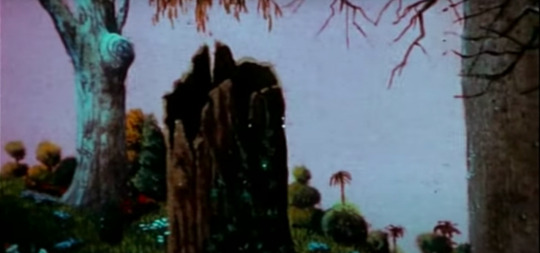
What are the Black purposes of space travel?
—Amiri Baraka, “Technology & Ethos”
Black futurism is a temporally troubled matrix Black futurism is a temporally troubled matrix that thrives on opposites and oppositions, flowing lines and nonlinearity, conflict resolution and asymmetrical warfare. It prefers the mad dash on shifting sands while in pursuit of higher ground and safe havens.
—Greg Tate, “Kalahari Hopscotch, or Notes Toward a 20 Volume History of Black Science and Afrofuturism”
Welcome aboard our spaceship, it’s so nice to have you here.
—Newcleus, “Space is the Place”
Who, constructing the house of himself or herself, not for a day but
for all times, sees races, eras, dates, generations,
The past, the future, dwelling there, like space, inseparable together.
—Walt Whitman
I’m so tired of being forced to promote the myth of white supremacy by performing works by old white men like Whitman who said blacks...didn’t have a place in the future of America.
—Timothy McNair
Today is the shadow of tomorrow,
today is the future present of yesterday,
yesterday is the shadow of today.
—Sun Ra, “Secrets of the Sun”
This highly allusive track from billy woods and ELUCID toys with itself—that is, allusions are a figurative means of collapsing time in and of themselves. Past and present history & culture don’t contend so much as support one another. A set of stilts to do the Dance of Death on, if you will. “Start downhill running.” The Seventh Seal hilltop silhouette danse macabre steez, though. The whooshing, metal-creaking beat—with all its haunted psithurism charm—is the backdrop for this sleeper Shrines track.
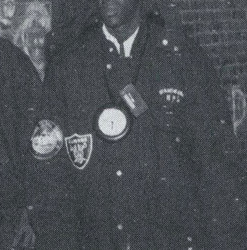
The name “Flavor Flav” is used metonymically here to mean time. This isn’t a braggadocio, low-key threat in the spirit of OC’s “Time’s Up.” This isn’t a Grandmaster Flashian “You Know What Time It Is” (though the hands on the clock tower do spin clockwise and counter-). Neither is this a Kool Moe Dee-esque rhetorical “Do You Know What Time It Is?” Armand Hammer are frustrated by time, by the “ideals and dreams that don’t work.” woods laments his “time machine [that] don’t go backwards.” This no-good lemon of a H.G. Wells contraption he’s steering. This isn’t some Christopher Lloyd-cum-El-Producto Delorean. There’s no Great Scotting going on, just stubbornness.
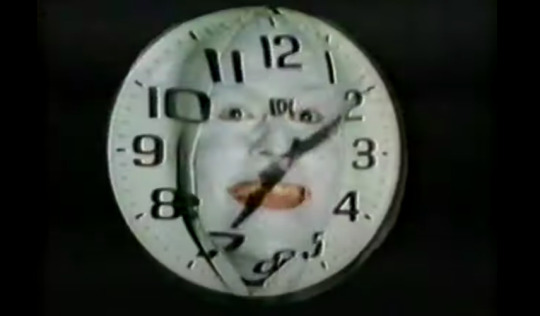

Progress isn’t made. Time stagnates. Like the “list of ill-fated quick licks under ’frigerator magnets.” And that “school trip permission slip”—likely a bus ride to a museum: a carefully curated collection of artifacts, most notable for its colonial muscling. The question remains: What is left out? What is excluded? What is ignored, discarded, or co-opted so as to not withstand the test of time? woods’ short-i assonance speeds the delivery up only to slow it down:
list | ill | quick | licks | ’frig | nets | trip | mis | slip | lick | split | skin | spliff
billy woods, son of a revolutionary, redefines Afrofuturism (re-re-re-defines—its brilliance is in how it remakes itself unconditionally). Afrofuturism becomes about birthing the next generation of Black revolutionaries, so he subverts the line and expectations when “big hand captured” refers to the clock, but “little man [not hand] chasin’” refers to a youngin. (Try to keep up.) Put the faith in the youth when our “ideals and dreams” stall out—when the days, months, years are fleeting and forceful (“It do tick faster / The hour coming rough”). The spliff that’s “[skinned] like an onion” turns the cypher into Perrault fairy tale “pumpkin,” Cinderella style.
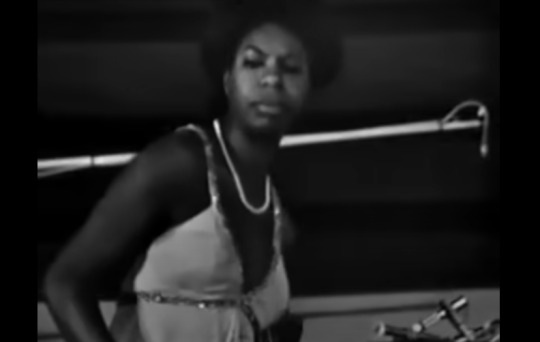
“Don’t come ’round with that ‘Go slow’” is in conversation with Nina Simone’s “Mississippi Goddam,” of course. It’s Nina who said “[she] can’t stand the pressure much longer,” who objected to those who “keep on saying ‘Go slow,” who had her band ironically chanting Do it slow. billy woods, like Nina Simone, decries reformism, incrementalism. Don’t do things gradually. We’re at the point where Nina stands up from her piano bench and shouts That’s it!
Forego the telephoto lenses, he insists, this is the “Battle of Algiers with the GoPro.” Urban guerrilla warfare uploaded and disseminated via YouTube. Again, time collapses. The struggle to decolonize continues. Watch for the This video is no longer available dead-end.

billy woods’ Nietzschean “loathing and fear” reverses the hallucinogenic time-warp of Thompson’s (and, in filmic relation, Gilliam’s) Fear and Loathing in Las Vegas. “History is hard to know,” Thompson writes, “because of all the hired bullshit, but even without being sure of ‘history’ it seems entirely reasonable to think that every now and then the energy of a whole generation comes to a head in a long fine flash.” That flash will reappear in ELUCID’s verse.
If “all roads lead to Rome,” we’re settling into the inevitability of our moves. It’s a fatalistic shrug, but homophonically, all roads lead to roam—that is, the journey is prolonged interminably. It’s nomadic. Much static. So, naturally, you’re going to “[shake] the hourglass like a snowglobe,” distort time, and splurge on the “JC Penny Timex,” which is appropriately “flooded with rhinestones.” Flooded, because no more water: the fire next time. Don’t “lose track” and don’t “get trapped in the future.”
The chorus quotes the Rolling Stones’ “Time is On My Side,” but it ain’t that simple, no. The history is as messy as we’ve come to expect amerikan music to be. “Time is On My Side” was originally penned by Norman Meade (Jerry Ragovoy), and trombonist Kai Winding first recorded it. Jimmy Norman, a Black songwriter, fleshed out the lyrics significantly, and Irma Thomas recorded that version in the same year as the Stones. The song followed a path similar to that of “Strange Fruit”—a composition written by a white Jewish man under a pseudonym (Abel Meeropol as Lewis Allan) but popularized by a Black female jazz singer (Billie Holiday). As author Jess Row has said about jazz—hip-hop applies, too—it is “by its very nature multi-racial, intermingled, and collaborative across color lines.” But this cognizance must always be contextualized with views of Black artists like that of Art Blakey: “the only way the Caucasian musician can swing is from a rope.” Hip-hop has always had its Paul Cs and Rick Rubins, but the racial heterogeneity of a genre, or even a single recording, can’t cloak the power dynamics still in play. The Stones’ version of “Time is On My Side”—undoubtedly the most popular version—is a rip-off of Irma Thomas’ version. Mick Jagger even jacks Thomas’ ad-libs, which is to say, her rawness and spontaneity. Even the band’s shadowed faces on the cover of 12 x 5, the album on which the track appears, suggest the racial problematics, the minstrelsy heist. Armand Hammer mock the British Invasion blues filchers by adding “they” to the chorus line: “They said time is on my side.” They being white institutions (especially within music publishing, production, and recording industries) who promised enough airtime for everyone. They who urged patience. (Go slow!) But, as history shows, the profits only lined certain pockets.
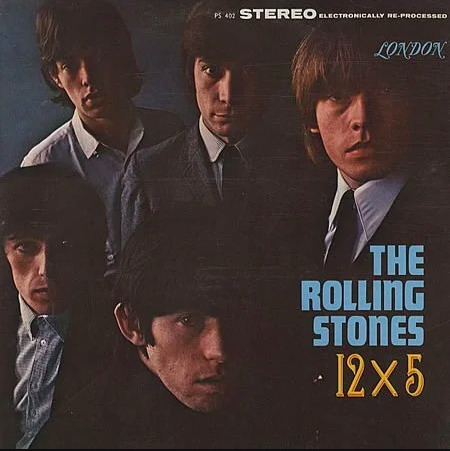
ELUCID begins at the “golden hour,” which is both the photogenic beauty of the sky after sunrise and before sunset—a beauty too good to behold. It’s the sun glare shining in your face on the winter commute from work. It’s your high-speed accident and then the golden hour is the paramedics and doctors trying to salvage your corporeal existence. ELUCID’s verse is a hypnagogic jerk, gasping for breath as he takes a “portal to Orangeburg, ’68.” It’s a reference to the campus shooting of young people in protest—South Carolina State University. Unlike Kent State, which came afterwards, Orangeburg didn’t get the attention keening white women in Pulitzer Prize-winning photographs do, despite “live ammunition,” three dead, 28 injured, and “nine acquitted assassins.” Unnoticed. Black invisibility. Not that H.G. Wells type of invisibility—the Ralph Ellison kind.
We’re told what this is: it’s the aggregate stress (“the load of the allostatic”) of Black life. It’s one’s personal Extinction Agenda, the “post-traumatic” of the gunfire “flashes” that double as flashbacks. The pain, stress, the brain that can’t rest, the pressure on the chest.
“The center won’t hold” lets us know this isn’t all PTSD reverie—it’s a rebel poem: surely some revolution is at hand. ELUCID channels Achebe channeling Yeats. Things might fall apart but not without struggle. The “Flavor Flav clock spins centrifugal,” as a gyre, as an apocalyptic (91…) voice. Turning and returning. The words have an air of insurrection, proclamation.
He misses “watching how a flat circle fold”—it won’t budge, won’t wrinkle. We’ve been here before: on “Hunter,” on Paraffin, when billy woods was on that “time is a flat circle” shit. That Nietzsche eternal recurrence shit:
What, if some day or night a demon were to steal after you into your loneliest loneliness and say to you: “This life as you now live it and have lived it, you will have to live once more and innumerable times more; and there will be nothing new in it, but every pain…will return to you. […] The eternal hourglass of existence is turned upside down again and again, and you with it, speck of dust!
“Can you find the level of difficulty in this?” suggests game playing, arcades. Calls to mind more Walter Benjamin’s Arcades, though. billy woods and ELUCID are gleaners and magpies of cultural cadavers in Benjamin’s way. Their bars are play and critique both. We’re left with a modicum of optimism at the song’s end. Even “only [moving] the pen six inches” is something, is struggle. The “pale faces beyond the fire” are ever-present, though. The “flinching, panic, [and] confusion” are committed to continue.
Is it the fool or the insurgent who thinks time is on their side? We want the life we live to be “more brilliant than a sunbeam.” That’s to say, we don’t want to wait for the golden hour or the golden years. We want what they say we can’t have. We want what they say we shouldn’t imagine. But Armand Hammer helps us take solace in the “drum skin stretched”—the rhythm, the rebel. The oft-quoted Douglass gem, If there is no struggle, there is no progress, is played out for a reason. The reason is because it needs to be played again, and again. Like a mantra, like a song.

Images:
Sun Ra’s Space is the Place (screenshot) | Flavor Flav (detail), courtesy of archivist Sean Stewart | Grandmaster Flash “You Know What Time It Is” music video (screenshot) | Kool Moe Dee “Do You Know What Time It Is?” single cover | Nina Simone live at Antibes Juan-les-Pins Jazz Festival 1965 (screenshot) | The Battle of Algiers (screenshot) | The Rolling Stones 12 x 5 album cover | Flavor Flav, courtesy of Stewart
2 notes
·
View notes
Text
Academic Book Review
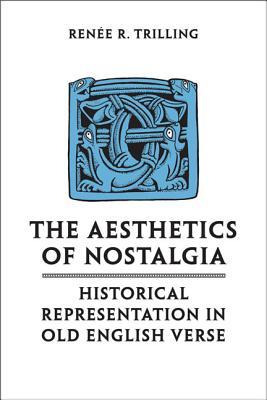
The Aesthetics of Nostalgia: Historical Representation in Old English Verse by Renée R. Trilling. Toronto: University of Toronto Press, 2009. Pp. 352. $26.96.
Argument: Heroic poetry was central to the construction of Anglo-Saxon values, beliefs, and community identity and its subject matter is often analyzed as a window into Anglo-Saxon life. However, these poems are works of art as well as vehicles for ideology. Aesthetics of Nostalgia reads Anglo-Saxon historical verse in terms of how its aesthetic form interacted with the culture and politics of the period. Examining the distinctive poetic techniques found in vernacular historic poetry, Renée R. Trilling argues that the literary construction of heroic poetry promoted specific kinds of historical understanding in early medieval England, distinct from linear and teleological perceptions of the past. The Aesthetics of Nostalgia surveys Anglo-Saxon literary culture from the age of Bede to the decades following the Norman Conquest in order to explore its cultural impact through both its content and its form.
***Full review under the cut.***
Chapter Breakdown:
Chapter One: Uses constellation theory to examine how Deor, The Ruin, and Widsith use history to meditate on temporality. Argues that non-linear time is used aesthetically in poetry to create understanding. Contains sections on constellation theory, meaning-making, sense of loss, material representations of space and time, simultaneity, and the heroic past.
Chapter Two: Argues that Old English biblical verse uses heroic/Germanic poetics to articulate Christian history. Understands Old English biblical verse as a hybrid text containing multiple cultural influences which affect the way the past is understood. Takes Genesis A and B, Exodus, Christ and Satan, and Bede’s and Ælfric’s translations as its foci. Contains sections on how (”unlearned” aka non-Latin) poetry conveys biblical history, affective relationships, creation and origin stories, sin and punishment, temporal juxtaposition, and allegorical reading.
Chapter Three: Examines verse memorials of events from the Viking Invasion. Takes The Battle of Maldon and Sermo Lupi ad Anglos as its foci. Argues that nostalgia fosters cultural identity by glorifying a haroic past. Contains sections on historical modes for reading pagan-Christian conflicts, heroism/heroic verse, and redemption.
Chapter Four: Examines the role of nostalgia in the verse of the Anglo-Saxon Chronicle. Argues that heroic poetry is used to record history to further ideologies about Wessex’s rule. Contains sections on prosimetrum, structure of the Chronicle, nationalism, Edgar and Edward the Confessor, and cultural identity.
Chapter Five: Argues that poetic passages in the Anglo-Saxon Chronicle are indicative of contemporary ideology and identity. Suggests change poetic form reveals changing models of historical consciousness. Contains sections on rhythm and rhyme, historiography, and “transitional verse.”
Theories/Methodologies Used
critical constellation theory (Walter Benjamin)
Hybridity (Homi K. Bhabha)
Reviewer Comments
I’ve always had an interest in the ways people record and memorialize history, so when I picked up this book for the first time, I was excited to learn about how nostalgia was deployed aesthetically in Old English verse. I enjoy reading academic books that remind me that poetry and literature are not objective witnesses to history - they are cultural objects that reflect ideologies and values, and Trilling effectively shows the reader how poetry from the early medieval period uses nostalgia to talk about the past.
My favorite part of Trilling’s book is her application of constellation theory. Prior to reading, I had never heard of it, and I found it mentally stimulating as a method for critical literary interpretation. Constellation theory presents concepts as having meaning when presented relative to other things. It allows readers to engage with material objects and non-linear time simultaneously. So, for example, a ruin is material and prompts a viewer to consider its past when it was whole. Trilling’s claim that meaning lies in the constellation was incredibly memorable, and I found the theory as a whole to be an exciting way to engage with aesthetics and art more broadly.
While I would not recommend this book if you’re unfamiliar with basic poetic concepts (like alliteration, meter, etc.), you also don’t need to be an expert on Old English verse to appreciate the arguments Trilling makes. She clearly explains each of her points and even her theoretical frameworks are easy to follow. Having a working knowledge of Old English will also be beneficial, as well as some familiarity with the history of Anglo-Saxon England, since Trilling works with events such as the Viking raids and Alfred’s dynasty.
Recommendations: This book is useful if you’re working on
nostalgia/representations of history (not “objective” history)
Old English poetics and poetic form
aesthetics
the Anglo-Saxon Chronicle
Christian vs heroic poetry
8 notes
·
View notes
Text
Read in 2017
January
Antonio Porchia - Voces
1917: Stories and Poems from the Russian Revolution
Kobo Abe - Identico al ser humano
Vasko Popa - Homage to the Lame Wolf: Selected Poems
Georges Bataille - Theory of Religion
Sylvia Plath - Ariel
Andre Gide - The White Notebook
Beyond the Visible: The Art of Odilon Redon
Zbigniew Herbert - The Collected Poems
Adam Zagajewski - Unseen Hand: Poems
Anne Sexton - Complete Poems
David Hinton - Classical Chinese Poetry
Eça de Queiros - The Yellow Sofa
Johann Wolfgang von Goethe - Selected Poetry
David Hinton - Mountain Poems: The Wilderness Poetry of Ancient China
February
Gennady Aygi - Child-and-Rose
Gennady Aygi - Field-Russia
The Story of Han Xiangzi: The Alchemical Adventures of a Daoist Immortal
Jacques Prevert - Selections from Paroles
Toson Shimazaki - The Broken Commandment
Jean Cocteau - Tempest of Stars: Selected Poems
Natsume Soseki - The Miner
Jean Cocteau - The Infernal Machine and Other Plays
Narim Bender - Auguste Rodin: 101 Drawings
Mario de Sa-Carneiro - Lucio's Confession
August Strindberg - The Stronger
August Strindberg - Facing Death
August Strindberg - Pariah
Ivan Bunin - Dark Avenues
Franz Kafka - The Zurau Aphorisms
Edvard Munch Lithographs Etchings Woodcuts
Toson Shimazaki - The Family
March
Alain de Botton - How To Think More About Sex
Josef Hirsal - A Bohemian Youth
Maurice Blanchot - The Madness of the Day
Miroslav Holub - Poems Before & After
Andre Breton - Poems
Stendhal - The Red and The Black
Paul Klee - Pedagogical Sketchbook
Donald Wigald - Klee
Paul Klee - Some Poems by Paul Klee
Arthur Schnitzler - Fraulein Else
Antal Szerb - The Third Tower: Journeys in Italy
Lu Xun - Selected Essays
Andrej Blatnik - Skinswaps
Statius - The Achilleid
Aleksander Wat - Lucifer Unemployed
Jacques Cazotte - The Devil in Love
Gerry Souter - Kazimir Malevich
Vladimir Lenin - Imperialism: The Highest Stage of Capitalism
Friedrich Engels - The Principles of Communism
Vladimir Lenin - State and Revolution
Pyotr Kropotkin - The Conquest of Bread
April
Pauline Reage - Story of O
Errico Malatesta - Anarchy
Sergey Nechayev - Catechism of a Revolutionary
Oscar Wilde - The Soul of Man Under Socialism
Joris-Karl Huysmans - A la Deriva
Andre Gide - Prometeo mal encadenado
Simone Weil - On The Abolition of All Political Parties
Walter Benjamin - El Autor Como Productor
Haruki Murakami - La Biblioteca Secreta
Fernando Pessoa - 35 Sonnets
Bertolt Brecht - Terror y miseria del Tercer Reich
Fernando Pessoa - El Primer Fausto
Fernando Pessoa - Diarios
Vasily Grossman - Life and Fate
Fernando Pessoa - La Hora del Diablo
Fernando Pessoa - El Banquero Anarquista
Andre Gide - Teseo
Jean-Paul Sartre - Existentialism Is A Humanism
Albert Camus - The Misunderstanding
The Showa Anthology: Modern Japanese Short Stories
The Sound of One Hand Clapping: 261 Zen Koans with Answers
Livy - The Early History of Rome: Books I-V
May
Bertolt Brecht - Antigone
Violette Ailhaud - L'homme Semence
Volodya: Selected Works
Stefan Zweig - Dos Hermanas
Stefan Zweig - El Amor de Erika Ewald
Stefan Zweig - Mendel el de los libros
Emile Zola - Nana
Stefan Zweig - Los milagros de la vida
Octave Mirbeau - Memoria de Georges el amargado
Federico Garcia Lorca - Bodas de Sangre
Samuel Beckett - Happy Days
Stefan Zweig - Ardiente secreto
Emile Zola - The Masterpiece
Akiko Yosano - Travels in Manchuria and Mongolia: A Feminist Poet from Japan Encounters Prewar China
June
Three Poets of Modern Korea
Santoka Taneda - For All My Walking: Free-Verse Haiku of Taneda Santoka with Excerpts from His Diary
Du Fu - Selected Poems
Yasmina Reza - El Trineo de Schopenhauer
Aleksandr Solzhenitsyn - The First Circle
Frank Wedekind - Spring Awakening
Yasmina Reza - Un Dios Salvaje
Yasmina Reza - Art
July
Junichiro Tanizaki - Enredadera de Yoshino
Arthur Schnitzler - Apuesta al amanecer
Bertolt Brecht - La Judith de Shimoda
Natsume Soseki - Habitaciones y otras piezas breves
Federico Garcia Lorca - Selected Poems
Franz Kafka - Contemplacion
Natsume Soseki - Tintes del cielo
Ilya Ehrenburg - The Fall of France Seen through Soviet Eyes
Victor Garcia - Three Japanese Anarchists: Kotoku, Osugi and Yamaga
John Reed - Ten Days That Shook The World
Louis Aragon - Los Ojos de Elsa
Rainer Maria Rilke - Primavera sagrada y otros cuentos de Bohemia
Ishikawa Tokuboku - On Examining One Self
Hugo von Hofmannsthal - Carta de Lord Chandos
Charles Baudelaire - Diarios Intimos
Masuji Ibuse - Lieutenant Lookeast and Other Storues
Paul Eluard - Selected Poems
Robert Walser - El paseo
Robert Walser - Poemas
Basileus Imperator Eduardus A Rodrigus
August
Marina Tsvetaeva - Moscow in the Plague Year: Poems
Eileen Chang - Un amor que destruye ciudades
Gustave Flaubert - Memoirs of A Madman
Henryk Ibsen - Hedda Gabler and Other Plays
Guillaume Apollinaire - Calligrammes
September
Wu Jingzi - The Scholars
Victor Hugo - Les Miserables
Gene Wolfe - Book of the New Sun Vol 2: Sword & Citadel
Giovanni Boccacio - The Decameron
Comte de Lautremont - Les Chants des Maldoror (read again)
October
Yasunari Kawabata - First Snow On Fuji (read again)
Yasunari Kawabata - The Lake (read again)
J.R.R. Tolkien - Children of Hurin (read again)
James Clavell - Gaijin
J.R.R. Tolkien - The Silmarillion (read again)
J.R.R. Tolkien - Unfinished Tales (read again)
Aleksandr Solzhenitsyn - Cancer Ward (read again)
J.R.R. Tolkien - The Lord of the Rings (read again)
November
Pierre Louÿs - La Mujer y el Pelele
Gustave Flaubert - Noviembre
Leo Tolstoy - War & Peace (read again)
Joris-Karl Huysmans - La-Bas (read again)
Oe Kenzaburo - Teach Us To Outgrow Our Madness: Four Novels (read again)
December
Fredy Pearlman - The Continuing Appeal of Nationalism
Fredy Pearlman - The Reproduction of Daily Life
Bertolt Brecht - War Primer
Friedrich Nietzsche - Aphorisms on Love and Hate
Fyodor Dostoyevsky - The Brothers Karamazov
344 notes
·
View notes
Text
Walter Benjamin’s Arcades Project is a vast montage of 19th century Paris in which he quotes and reflects on topics such as Parisian arcades, fashion, flaneur, advertising, prostitution, etc. By rag-picking from printed sources a wealth of details about daily existence, Benjamin brings to life a world of things. As a start of the research project, the first Chapter of the Arcades Project is carefully examined and redrawn with my understanding in two mediums – literary and visual montage. From there, the derived method of presenting Paris is adopted and applied to the research of Singapore’s Heartland and the Central Business District (CBD), the area of interest and the site of the project, respectively.
Section A: Infilling the CBD with Urban Living
Heartland
In heartlands, state-imbued “perfection” relating to orders and standards had been constructed and applied to many aspects, from architecture, conducts, to government documents. As inspired by Walter Benjamin’s Arcades Project, the research project explores the authentic image of the heartland by “rag-picking” gaps that are excavated from a myriad of resources, ranging from online articles, publications, to poems and photographs by local artists. The research unveiled that under the state-constructed perfection, gaps are created mainly through the users and usages. The beauty of gaps makes heartlands colourful and livable places that redefines the idea of perfection.
CBD
While also having a “perfect” image in terms of its planning and urbanscape, the CBD for the period of post-pandemic are analysed using the same method of research. By looking at categories such as Architecture and History of Land Reclamation, gaps are identified as the rich supply of amenities that used to be carriers of social lives pre-pandemic, but left severely underused when their users vanished because of the pandemic policies. Such amenities identified on site include bars and restaurants and shops and supermarkets (e.g. 7-11s). Hence, with social amenities in place in the CBD, bringing back users and urban living becomes the pending issue.
Further Inspired by the idea of the flaneur, the social life observer, conveyed in the Painter of Modern Life by Charles Baudelaire and A Bar at the Folies-Bergère by Édouard Manet, the project proposes a new protagonist of urban living – the delivery man, the overlooked contemporary user and observer of post-pandemic urban living.
Section B: Accommodating the Delivery Men as Contemporary Users and Observers of the New Normal
The Users of the New Normal
The pandemic and the aftermath saw the CBD devoid of life and activities. While work-from-home policies emptied the skyscrapers, supporting amenities like restaurants, bars, convenience stores were affected. The lack of a residing population within the CBD further meant that these facilities and public urbanscapes became transient spaces, namely thoroughfares for services and especially the delivery person, who travels back and forth between these service providers and the populated HDB districts located at the periphery of the CBD to deliver food and services. While the objective of infilling the CBD with urban living is underlined in Section A of the project, the profession of the delivery man, as an overlooked user of urban space under the new-normal is also highlighted.
The Observers of the New Normal
The implementation of the various phases of lockdowns have limited most activities to the home, and gatherings to small numbers. As a result, the delivery personnel who move about have become the main connective conduits for people and the activities that cannot be personally carried out. Similar to Mr M. G., the 19th century Parisian flaneur concocted in the imagination of Charles Baudelaire in his book, the Painter of Modern Life, Mr and/or Ms Delivery in this instance is the contemporary protagonist who observes and collects different forms of lives at every corner of Singapore, though not in the form of paintings, and not in prolonged moments in cafés but through continuous movement.
While moving between households and businesses, Mr. and Ms. Delivery see snippets of life, intermittently hear whispers, cries or laughter, and have brief conversations with different individuals. On job review websites, though complaints such as “constantly on-the-go” and “fast-paced and back-breaking” appear from time to time, indicating a need to design proper work-life balance and specialized facilities, the happiness working as a delivery person can also be glimpsed: “learned much about the community with people”, “learn more about people characteristics and behavioural”, “see something new every day”, “make a good friend”.
Thus, this project proposes to enhance the positive qualities of this often overlooked profession and explore their contributions as ‘modern flaneurs’ and observers of the urban scape and urban living, by creating a heterotopia through networks and spaces that foregrounds Mr and/or Ms Delivery and their daily adventures.
The proposed architecture occupies and connects the left-over and in-between spaces amongst the existing vacant skyscrapers. Hence, from the reclaimed ground from where the CBD sprung, the airspace has now also been reclaimed. The architecture comprises of three integrated layers that supplement each other. The first is the connections crossing over the space in-between existing skyscrapers. They capitalise on the fast and slow movements of the delivery people, paying special attention to opportunities that exaggerate ‘slower’ movements, allowing the design to encapsulate the fun aspects– observing and exploring urban living - of their job. The second comprises of housings, shops, markets, and playgrounds that infill urban living into the CBD. The last layer consists of specially designed facilities for Mr and Ms Delivery in order to address their needs as overlooked users of urban space. These facilities such as parking, storage and charging, and service and maintenance perform as walls, floors and structures that supplement the first and second layer.
In summary, the proposed network infills the CBD with heartland living to revitalize the current CBD while also function as places of work-life balance after the pandemic. In addition, the profession of the delivery man that has been foregrounded during the pandemic is taken as the protagonist of the heterotopia, which is designed for them to enjoy quality working as a user in the new normal and ensue his or her identity as an observer of the new normal. The collation of Mr and Ms Deliveries’ experiences creates a unique montage of post-covid urban living that forms a chapter in the Singapore version of Walter Benjamin’s Arcades Project.
Chai Ruige
0 notes
Text
Jules Verne’s Mystorians.
Probably my favorite or second Favorite organization. Okay, tied for Favorite Organization with the Caretakers. I just really like the Mystorians you guys. So. The Mystorians are a splinter Group of the Caretakers founded by Prime Caretaker Jules Verne, with the Aproval of Edgar Allan Poe, and ’led’ William Blake (though there’s no Seniority among them. Unlike the more active and field working Caretakers, the Mystorians are mainly concerned with the affairs of the Summer Country. Observing, and occasionally acting in some capacity. Their main base of Operations is the Hotel D’Ailleurs in Switzerland. Each member is addressed as Doctor since everyone got tired of Franklin lording his Honorary Doctorate over everyone. The Mystorians include, but are not limited to. In no particular order. DR BENJAMIN FRANKLIN: American Inventor, Writer, and Statesman. Inventor of the Stove (among other things) Helps John, Jack, Rose and others when they find themselves in Colonial America (Philadelphia I’m pretty sure). He offers them shelter, and discusses the Alphabet with Uncas or Fred. Manifests in the Wonder Cabinet in the Hotel D’Ailleurs as a Ghost. DR. L. FRANK BAUM: American Writer, best known for the Oz books. Has met Santa Claus. Has likely met Roger Bacon( Tin Man). Has an understanding of Time and Space. One of several to insist on being addressed as Doctor. Manifests as a Ghost in the Wonder Cabinet. DR LEWIS CAROLL( aka Charles Dodgeson): English Writer, Mathematician, Photographer, and Ocultist. Best known for the Adventures of Alice in Wonderland and Through the Looking Glass. Can tell you the secrets of Time in a Poem. Probably had some hand in the making of the Lanterna Magica...probably. Manifests as a Ghost in the Wonder Cabinet. DR. ROBERT E. HOWARD: American Writer, best known his books featuring Conan the Barbarian. Manifests as a Ghost in the Wonder Cabinet. DR. CHRISTINA ROSSETTI: English Poet, best known for The Goblin Market. Strangely enough although she appears at the Hotel D’Ailleurs, she is earlier noted as a member of the ICS, and her last known location was being lost in Fairy land. She may have had two Tulpas, one with the ICS, and one with the Mystorians. DR. ARTHUR MACHEN: Welsh author and Mystic. Best known for his works in Fantasy and Horror, such as the Great God Pan. Manifests as a Ghost in the Wonder Cabinet. DR. HOPE MIRRLESS: British Translator, Poet, and author. Best known for Lud in the Mist. From my understanding she is still alive at the end of the series. If not, then she likely will Manifest as a Ghost in the Wonder Cabinet. May just pass on, depending on the necessity of the Mystorians following the defeat of the Cabal. DR. SIR ISAAC NEWTON: English Mathematician, Alchemist and ‘Natural Philosopher ‘(Physicist). Best known for his three laws of motion, and Universal Gravitation. Manifests as a Ghost in the Wonder Cabinet. DR. DR. DEMETRIUS DOBOBE: I can’t find anything about him. He appears in a book by Sir Walter Scott (a Fiction), but I cannot find which. Manifests as a Ghost in the Wonder Cabinet. DR. MASTER ERASMUS HOLIDAY: SAME AS DOBOBE. DR. GEORGE MACDONALD: Scottish Author, Poet, and Christian Minister. Perhaps best known for his Art Fairytales such as the Princess and the Goblin, and The Light Princess(which everyone should read by the way. One of my favorites). Noted to have been a friend and mentor to fellow Mystorian Lewis Carroll. Friend to Mark Twain (probably Shadowed him). Noted influence on Tolkien, Lewis, Madeline L’Engle, and Chesterton. Manifests as a Ghost in the Wonder Cabinet. DR. AGATHA CHRISTIE: English Writer and Playwright. Known for her works in the mystery genre. Notably her Detective fiction featuring characters such as Hercrule Piroit, and Miss Marple. Alive during the series. Noted to have Shadowed John. Will likely later Manifest as a Ghost, or move on. DR. ARTHUR C. CLARKE: British Science Fiction Writer. Perhaps best known for 2001: A Space Odyssey among other works. Alive during the series. Probably will Manifest as a Ghost? DR. ISAAC ASIMOV: Russian Science Fiction author. Perhaps best known for the Foundation Series, and I, Robot. Developed a system ( I forget the name) to aid the Mystorians in looking for the lost Prince Coal. May end up manifesting as a Ghost upon his death? DR. JOSEPH MERRICK: Known to History as the Elephant Man due to his physical deformity ....Manifests as a Ghost with no deformity present in the Wonder Cabinet. Helps lead the Mystorians to safety following an Attack by Nikola Tesla of the Cabal. Do correct any details...I know I must be missing something here. DR. H.G ‘Herb’ WELLS: English Author best known for his Science Fiction Work such as the Time Machine. He is the Wells that did not end up traveling through time and become a Caretaker. Verne’s Ace in the Hole. Upon his death he does not Manifest as a Ghost...having the envy of some of the Mystorians... DR. WILLIAM BLAKE: Blake’s Seven. Painter and poet. Designed the watches for the Cabal. Began the Pygmalion Gallery. Had made Seven Tulpas. One infiltrating the ICS, Three Infaltrating the Cabal, and three remaining with the Caretakers and Mystorians. Noted to be the True leader of the Mystorians. Possible Mystorians. DR. DANIEL HANDLER (aka Lemony Snicket). American Writer best known for Lemony Snicket’s Series of Unfortunate Events. Chronicling the lives of the Bauldelaire orphans...given the nature of Snicket’s narration and involvement in Secret Societies, he seems like a good fit for the Mystorians. So there’s that. Make of it what you will.
4 notes
·
View notes
Text

1900 Booker T. Washington founds the National Negro Business League.
Washington publishes his first autobiography The Story of my life and work editor of the New York Age Timothy Thomas Fortune.
October Washington invited for dinner at the White House by President Theodore Rosevelt.
Du Bois attends the First Pan-African Conference in London drafts letter ”Address to the Nations of the World” to the European heads of states.
Seay becomes certificate as an educator teaches in Mayan village of Xcalak in Mexico.
1901 Garvey becomes apprentice to printer Alfred ‘Cap’ Burrowes in his native parish of Saint Ann.

W.E. B. DuBois with his wife Nina and daughter Yolande ca. 1901
Washington publishes his autobiography Up From Slavery.
Washington recieves honorary decorate from Dartmouth College.
1903 Du Bois publishes his 14 essay book The Souls of Black Folk.

1904 Garvey relocates from his native parish of Saint Ann 25 miles away to Alfred Borrows branch in Port Maria, Saint Mary.
1905 Garvey moves to Smith Village, Kingston at 13 Pink Lane in begins working for P. A. Benjamin and exceeds to the position of foreman.

Booker Washington and Theodore Roosevelt at Tuskegee Institute, 1905.
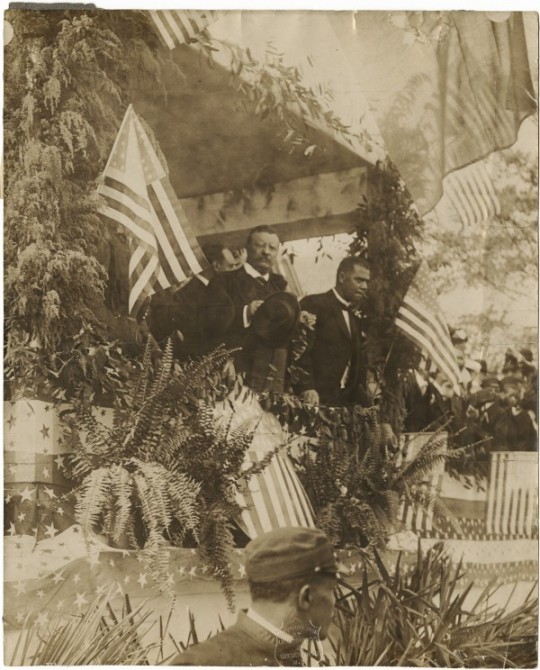
December Du Bois buys printing press and publishes Moon Illustrated Weekly.

1906 January 23 Washington giving a speech at Tuskegee Institute Silver Anniversary Lecture Carnegie Hall in New York City.

Du Bois and American Civil Rights activists meet in Canada write declaration opposing Washington's Atlanta Compromise and form the Niagara Movement.
August Second Niagara conference West Virginia Harpers Ferry John Brown raid.
September Atlanta riots 10 thousand whites, 25 deaths.
Du Bois publishes his “A Litany at Atlanta” essay.
1907 Hubert Harrison begins working at the United States Post Office.
Garvey elected vice president of the compositors branch of the Kingston Typographical Union.
Du Bois publishes The Horizon: A Journal of the Color Line.
Philadelphia Quaker Anna T Jeanes donates one milion dollars to Booker T washington.

1908 November 28 Garvey participates in Jamaica Print worker strike.
18 March Garveys Mother Sarah Richards passes away at age 56.

1909 Washington tours southern Virginia and West Virginia.
May Du Bois attends the First National Negro Conference in New York where National Negro Committee is created chaired by Oswald Villard.

Orientalist Dr. Carl Bezold publishes his edition of the Book of the Glory of Kingswith a German translation.
1910 Du Bois attends the Second National Negro Conference Committee where they create the National Association for the Advancement of Colored People (NAACP), Du Bois becomes Director of Publicity and Research for editor of its monthly magazine the Crisis.
Harrison writes two letters to the New York Sun critical of Booker T Washington which cost him his job at the United States Post Office.
Garvey travels to Costa Rica where he is employed as a time keeper on a Banana plantation.
20 April Garvey elected first assistant secretary of the National Club and Wilfred Domingo Apprentice Tailor, second assistant secretary. Fortnightly journal Our Own. Garvey and Domingo The Struggling Mass pamphlet.
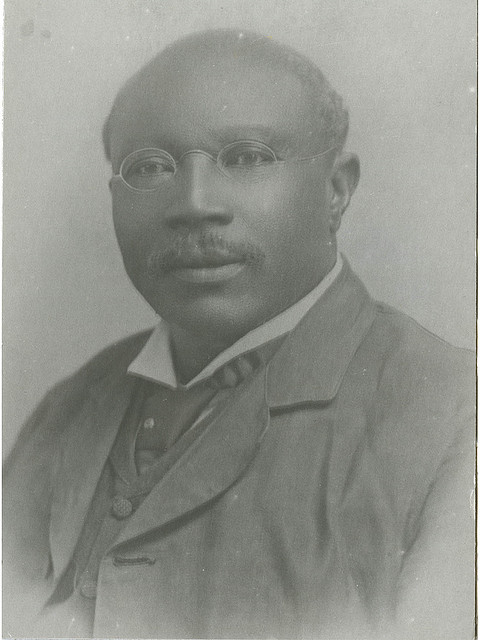

Garvey enrolls for elocution lessons with Jamaican Dr. Robert J Love monument George William Gordon.
Garvey publishes three issues of his Watchman journal namd after George William Gordon’s journal the Watchman.
November Du Bois publishes the first issue of The Crisis.
1911 Harrison begins work at Socialist Party of America becoming Americas leading black socialist.
Du Bois attends First Universal Race Congress in London, publishes his Quest of the Silver Fleece novel and joins the Socialist Party of America.
Garvey becomes editor of daily newspaper La Nacionale in Costa Rica and later travels to Colon, Panama.
July 26 Universal Races Congress among its attendees Harry Johnston of the Royal Geographical Society, Sir Sydney Olivier Governor of Jamaica.
April 25, 1911 - The Nation (edited by Marcus Garvey) Cover Page.
July 26 Universal Races Congress among its attendees Harry Johnston of the Royal Geographical Society, Sir Sydney Olivier Governor of Jamaica.
1912 Julius Rosenwald begins serving on the board of directors of Tuskegee Institute.
February 7 Blyden passes in Freetown, Sierra Leone.
Harrison campaigns for Industrial Workers of the World founder Eugene V. Debs, presidential candidate, writes the Negro and Socialism for the socialist newspaper the New York Call as well as the socialist monthly the International Socialist Review, also founds the Colored Socialist Club and speaks at Broad and Wall Street in front of the New York stock exchange on socialism.
Garvey sails to London where he attends evening classes at Birkbeck College.
August Garveys sister, Indiana, joins him in London.
Du Bois supports the Democrat Woodrow Wilson in presidential campaign forcing him to resign from Socialist Party of America.
Julius Rosenwald begins serving on the board of directors of Tuskegee Institute.
1913 Garvey begins working for Dusé Mohamed Ali at the African Times and Orient Review office at 158 Fleet Street as messenger and handyman, in October issue writes The British West Indies in the Mirror of Civilization essay. Dusé Mohamed Ali was also later to become the foreign secretary for Garveys Universal Negro Improvement Association.

Garvey travels to Scotland.
Garvey granted month long readers pass to the British Museum library, where he reads Edward Wilmot Blyden’s Christianity, Islam and the Negro Race as well as Booker T Washington’s autobiography Up from Slavery.
Claude Mckay attends Tuskegee Institute.

W.E.B. DuBois and members of the New York State Commission on the occasion of the fiftieth anniversary of the Emancipation Proclamation in 1913.

Organizers of the 1913 Silk Strike in Paterson, New Jersey. Front row, from left: Hubert Harrison, members of the Industrial Workers of the World Elizabeth Gurley Flynn, and “Big Bill” Haywood. Back row: unknown, Patrick L. Quinlan, unknown, and unknown. Photographer unknown. Courtesy the American Labor Museum, Haledon, New Jersey, and Jeffrey B. Perry.
Six new small schools in rural Alabama funded by Rosenwald built and opened.
1914 Crisis magazine article 2,732 lynchings from 1884 to 1914.
Marcus Garvey founds the Universal Negro Improvement Association at 12 Orange Street, Kingston.
August Garvey meets Amy Ashwood at the Queen Street Baptist Literary and Debating Society U.N.I.A. moved to 20 Orange Street, Kingston.
October Tsar Nicholas II October manifesto freedom of speech and suffrage.
The Russian army invade Germany.
Alfred Charles Sam Akyem Abuakwa Gold coast Texas, Oklahoma.
1915 Harrison publishes The Black Man’s Burden Rudyard Kipling.
Du Bois publishes The Negro and “The African Roots of the War” essay, Atlantic Monthly and fights with the NAACP to band The Birth of a Nation film, the Crisis magazine also publishes article 2,732 lynchings from 1884 to 1914.

135th Street Lenox Avenue Harlem speakers corner.
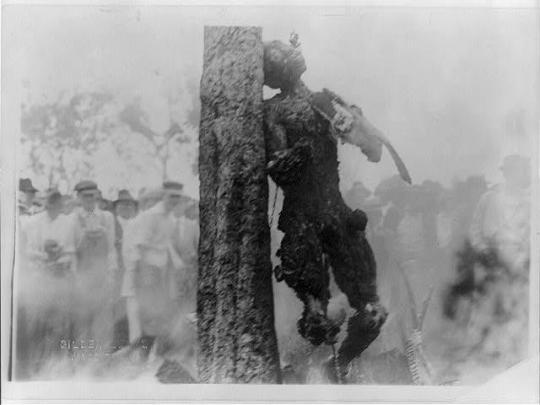
Tsar Nicholas assumes Commander in Chief.
1916 Crisis magazine April issue lynching of six in Lee County, Georgia and June issue “ Waco Horror” article lynching of mentally impaired 17 year old Jesse Washington in Waco, Texas.
March Garvey departs from Jamaica to New York on the SS Tallac.
April 25th Garvey heads to the NAACP offices at 25 695th Avenue in search of Du Bois.
May 9, Garvey holds his first public lecture in New York City at St Mark’s Church in-the-Bowery where he becomes overwhelmed whilst speaking and falls off the stage.
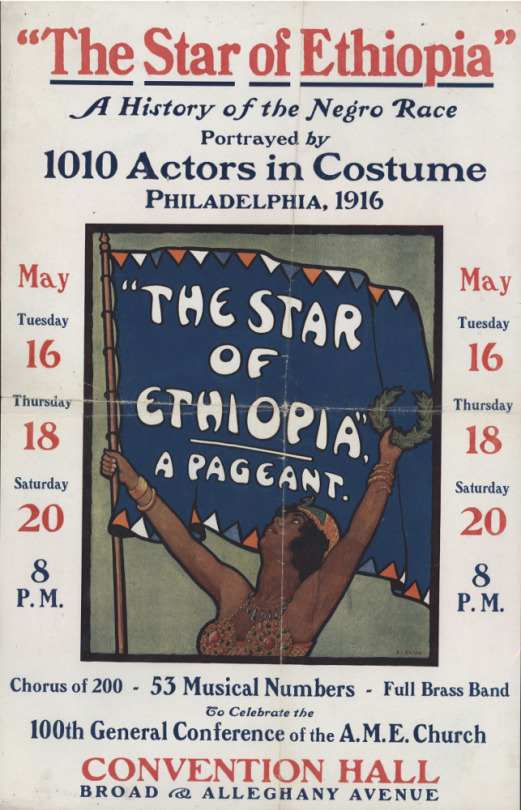
The Star of Ethiopia a pageant of the history of black people from 50,000 B.C to 20th century wrote, produced, and directed by WEB Du Bois.
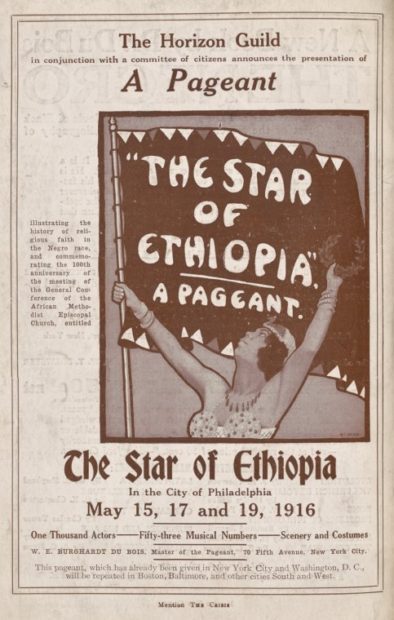
Lucien B. Watkins poem The Star of Ethiopia.

December Grigori Rasputin murdered by Prince Yusopor.
1917 Garvey and thirteen others the Harlem, New York branch of the UNIA,

Asa Philip Randolph and Chandler Owen also found the Messenger monthly magazine, earlier the same year A Philip Randoph had stepped down from his stepladder in Harlem to let Garvey speak.
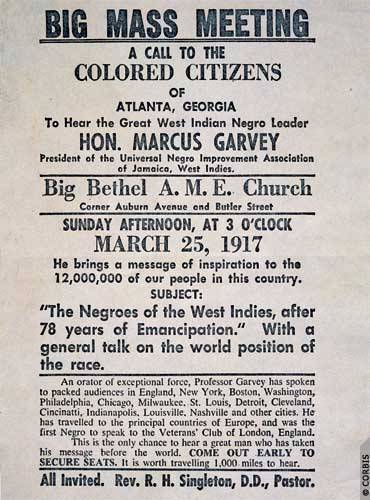
March Tsar Nicholas II resigns.
April Vladimir Lenin returns to Russia from exile in Switzerland flee to Finland.
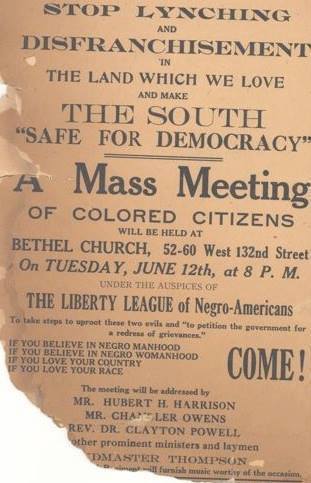
Harrison founds the Liberty League and Voice newspaper.
12 June Harrison and Marcus Garvey speak at Harrisons Liberty League of Negro Americans meeting at the Bethal African Methodist Espicopal church.

July 1 East Saint Louis riots, white drive by and fire shots, journalist and two police men drive by Blacks open fire on car killing one officer, thousand of whites begin rioting. women, blacks lynched Congressional Investigating Committee reports 39 blacks, 9 whites dead although thought to be more like hundreds, 6 thousand Blacks left homeless after their neighbourhood burned.
July 8 Garvey at Lafayette Hall speaks on the East Saint Louis riot The conspiracy of the East St. Louis Mayor Mollman migration riots printed pamphlets.

July 28 Du Bois and NAACP organise and lead a “Silent March” of 10,000 black New Yorkers down Fifth Avenue to protest the East St. Louis race riot, Du Bois also travelled to St. Louis to report on the riots and publishes the article "The Massacre of East St. Louis" in September.

October 16 Lenin returns to Russia.
October 24th/25th Bolshevik Provisional Government Petrograd Soviet.
1918 Garvey on his birthday founds the Negro World weekly newspaper.
Garvey holds UNIA meetings at Palace Casino Theater 135th Street Madison Avenue.
Harrison works with the American Federation of Labor and serves as chairman for the Negro American Liberty Congress co-headed by Monroe Trotter, the AFL also submits petition to the U. S. Congress for federal anti-lynching legislation.
According to the Hymn From Greenlands Icy Mountains had been adopted by the UNIA and sung at this meeting it is also used by the RasTafarite Ethiopia Black International Congress.
August 4 Randolph and Owen in Cleveland at Social Party leader Walter Bronstrups meeting arrested by Department of Justice official to be trailed on the charge of violating the Espionage Act.
“unlawfully, knowingly and feloniously, the United States being then and there at war with the Imperial German Government, willfully print and cause to be printed, publish and cause to be published, circulated, in a certain language intended to incite, provoke and incur resistance to the United States and to promote the cause of its enemies in a certain publication known as the Messenger.”
6 October 1918 Amy Ashwood arrives from Panama.
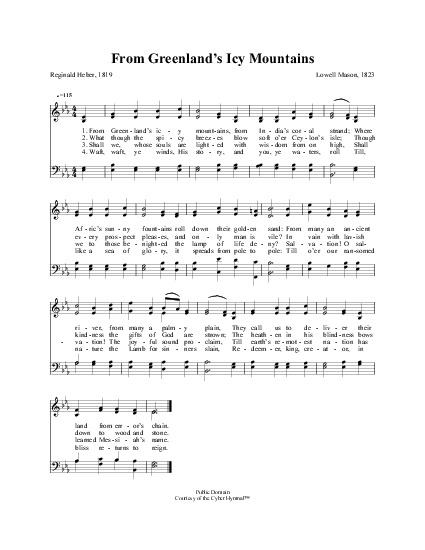
According to the Hymn From Greenlands Icy Mountains had been adopted by the UNIA and sung at this meeting it is also used by the Ras Tafarite Ethiopia Black International Congress.
1919 January 18 the year long Versailles Peace Conference is held in Paris France. Treaty of Versallies Germanys possessions Hiltler re militarization June 28 and creation of the League of Nations.
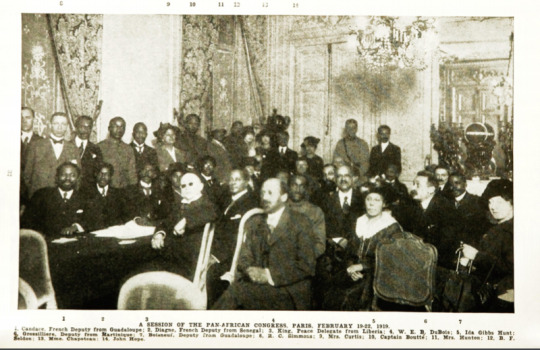
WEB Du Bois with the help of Senegalese deputy to the National French Assembly Blaise Diagne organized the First Pan African Congress to be held in Paris.
The 20 year old Haitian Elizier Cadet elected as a delegate, interpreter, main negotiator and later high commissioner to the Conference, presents the resolutions of the UNIA that Germanys confiscated colonies be governed by Negroes educated in America and Europe, to the President the French PM Georges Clemenceau, Cadet also camped outside the offices of the Parisian newspapers of the Liberal La Matin editor, as well as the editors of La Presse and L’Instansigeant newspapers who promised to publish the articles.
Ida B. Wells and Randolph were also elected as delegates but were unable to obtain passports and visas.
German East Africa Tanganika designated to Britain, South West Namibia Cameroon, and Togo to France and Britain, Urundi Burundi to Belgium and Namibia South Africa
January 21 Seattle Shipyard Strike 35, 000 workers go on strike. Unions in Seattles shipbuilding industry demand pay increase for unskilled workers, the yard owners offer to give a pay increase to skilled workers, the union reject the offer and go on strike.
February 23 Third Irish Race Convention Philadelphia.

Soldiers of the 369th (15th N.Y.), awarded the Croix de Guerre for gallantry in action, 1919. Left to right. Front row: Pvt. Ed Williams, Herbert Taylor, Pvt. Leon Fraitor, Pvt. Ralph Hawkins. Back Row: Sgt. H. D. Prinas, Sgt. Dan Storms, Pvt. Joe Williams, Pvt. Alfred Hanley, and Cpl. T. W. Taylor.

Pvt. Henry Johnson nicknamed “Black Death”.
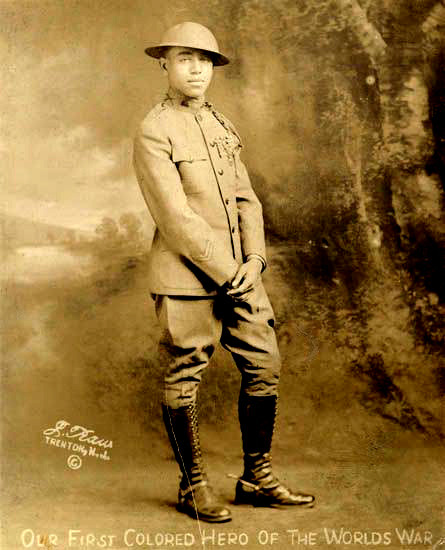
Pvt. Needham Roberts.
Johnson who using his broken rifle as a club and Roberts with a 9 inch bolo knife defeat a 24 German in France awarded.
$10, 000 $35, 000 steam paddle ship SS Shadyside SS Kanawha.
The UNIA property located at 114 West 138th Street, New York City which had previously been the Metropolitan Baptist Tabernacle and which would now become the first of many of the UNIAS Liberty Halls.
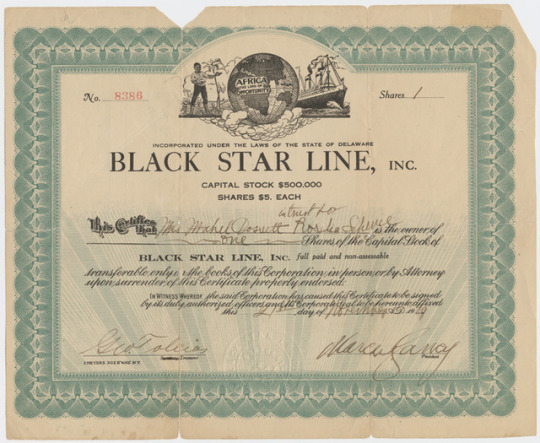
The Black Star steamshipping line was also established.
Garvey and the UNIA investigated by the FBI then the BOI. Major Walter Howard Loving Negro World Probable Bolshevik Propaganda.
Bolshevik meaning majority, referring to the Marxist majority of the Russian Social Democratic Party of which Vladimir Lenin and Leon Trotsky came into power in October 1917 and the influence of its socialist, communist and Soviet regime.
Supported by German or Bolshevik money.
February 4 U.S. Senate votes to Overman Judiciary Subcommittee for more investigation of German spies and Bolshevik propaganda. committee month hearing February 11.
February 6 to 11 Seattle, Washington General Strike. Head of Emergency Fleet Corporation sends telegram mistakenly to Metal Trades Council rather than Metal Trades Association withdraw contracts of any given wage increase, the workers appeal to Seattle Central Labor Council for the strike.
General Strike Committee formed to provide essential services throughout the city during the strike, Army Veterans form Labor War Veterans Guard to ensure order throughout the city although.
“Russia Did It” pamphlet overthrow.
Mayor Hanson police and military order federal troops, stations 950 sailors and marines February 7. 600 hires men to the police force hires 2, 400 deputies.
February 8 The executive committee of the General Strike Committee by AFL and international labor organizations to end the strike at midnight but voted against by the General Strike Committee.
February 9 Mayor Hanson “sympathetic strike was called in the exact manner as was the revolution in Petrograd”.
February 10 The General Strike Committee vote to end the strike the next day.
39 Industrial Workers of the World members arrested ringleaders anarchy.

April bombs mailed to Government officials, businessmen such as John D Rockefeller, Mayor of Seattle Ole Hanson receives mailed packaged bomb opened at the wrong end by member of his office staff William Langer, who then takes the bomb to the police and notifies Post Office.
Police officers turn up at the UNIA headquarters with a search warrant after an anonymous tip of that from the office of the Negro World. At Garveys Carnegie Hall meeting agents of the Lusk Committee also turn up with a bomb squad.
J Edgar hoover begins to hold suspicions of the Harlem offices of the Negro World and the Messenger being the Russian organ of Bolshevism in New York. Garvey papers II page 674. 642 of the Russian organ of Bolshevik from one memo J Edgar Hoover special assistant to Attorney General to Frank Burke Washington D.C. August 12 1919 Garvey papers I page 480.
May Day Boston Police attempt to stop unpermitted march, fight for socialist Soviet Union Red Flags, one policeman fatally stabbed, socialist HQ attacked by mob, 114 arrested.
At the Russian Peoples House social club, soldiers burn printed material and force emigrants to sing Star Spangled Banner.
Cleveland, Ohio protesting the imprisonment of Eugene V. Debs and promoting the campaign of Charles Ruthenberg the socialist candidate for Mayor plan march.
Nationalist group Victory Loanworkers try to block marchers, Ruthenbergs HQ attacked by mob, police mount with trucks and tanks, tank driven into crowd, two dead, 40 injured, 116 arrested.
June 2 Bombs judges sentenced anarchist to prison, Attorney A. Mitchell Palmer targeted for the second time, Carlo William Valdinoa editor of Galleanist publication Cronaca Sovversiva Luigi Galleani, delivers the bomb, trips up, the bomb detonates leaving his body parts on Palmers lawn.
Flyer traced to anarchists Andrea Salsedo, who commits suicide and Robert Elia.
June Attorney A. Mitchell Palmer Carlo William Valdinoa Galleanist trips up bomb detonating body parts lawn.

Senator Lusk chairman of committee anarchy socialists troops office of Industrial Workers of the World and Rand school for racial propaganda Socialism Imperilled, or the Negro a Potential menace to American radicalism article by Wilfred Domingo editor of the Negro World who worked with Garvey in 1910 at the National Club.
June 2 Bombs judges sentenced anarchist to prison, Attorney A. Mitchell Palmer targeted for the second time, Carlo William Valdinoa editor of Galleanist publication Cronaca Sovversiva Luigi Galleani, delivers the bomb, trips up, the bomb detonates leaving his body parts on Palmers lawn.
Flyer traced to anarchists Andrea Salsedo, who commits suicide and Robert Elia.
July 28 Garvey charged with criminal libel against Richard Warner, Edgar Grey and the District Attorney Kilroe, Garvey incarcerated in Tombs prison and bailed for $3,000.
A Red Summer.
The Red Summer racial riots were a series of riots 38 which occurred between May and October 1919.
December Crisis issue Omaha, Nebraska.
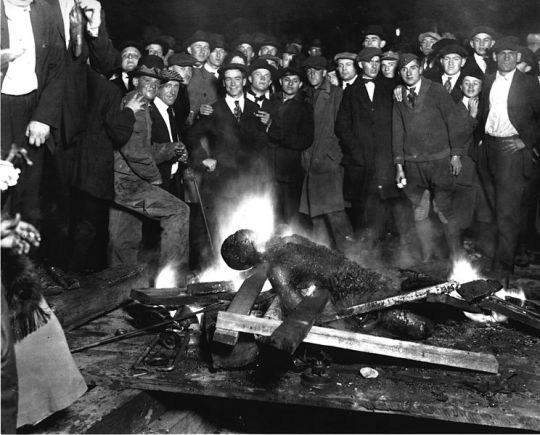
Will Brown, Victim of Omaha, Nebraska violence.
Mary Turner.
May 10 Charleston, South Carolina
May 10 Sylvester, Georgia
May 29 Putnam County, Georgia
May 31 Monticello, Mississippi
June 13 New London, Connecticut
June 13 Memphis, Tennessee
June 27 Annapolis, Maryland
June 27 Macon, Mississippi
July 3 Bisbee, Arizona
July 5 Scranton, Pennsylvania
July 6 Dublin, Georgia
July 7 Philadelphia, Pennsylvania
July 8 Coatesville, Pennsylvania
July 9 Tuscaloosa, Alabama
July 10 Longview, Texas
July 11 Baltimore, Maryland
July 15 Port Arthur, Texas
July 19 Washington, D.C.
July 21 Norfolk, Virginia
July 23 New Orleans, Louisiana
July 23 Darby, Pennsylvania
July 26 Hobson City, Alabama
July 27 Chicago, Illinois
July 28 Newberry, South Carolina
July 31 Bloomington, Illinois
July 31 Syracuse, New York
July 31 Philadelphia, Pennsylvania
August 4 Hattiesburg, Mississippi
August 6 Texarkana, Texas
August 21 New York City, New York
August 30 Knoxville, Tennessee
September 28 Omaha, Nebraska
October 1 Elaine, Arkansas
Elaine, Arkansas, arrested and tried for conspiracy in the Moore v. Dempsey case.
28 July Garvey charged with criminal libel against Richard Warner, Edgar Grey and the District Attorney Kilroe, Garvey incarcerated in Tombs prison and bailed for $3,000.
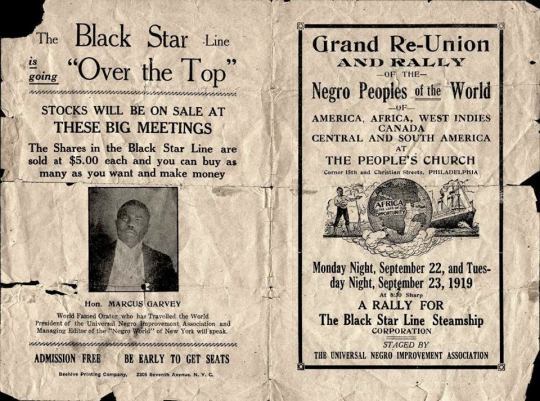
28th September Garvey, Reverend Eason, Amy Ashwood and Henrietta Davis Illinois south for meetings at the 8th Regiment Armoury the home of the all Negro infantry Garvey was arrested by detective George Friend of the Chicago Constabulary on violation of the Blue Sky Law turned out to be a private detective from Keystone Detective Agency who was hired by Robert Abbott editor of the Chicago Defender and taken to Harrison police station.
September Henrietta Vinton Davis that there were 7, 500 members in New York alone and branches in 25 states of Union.
11 October memorandum from J Edgar Hoover to special agent Ridgely.
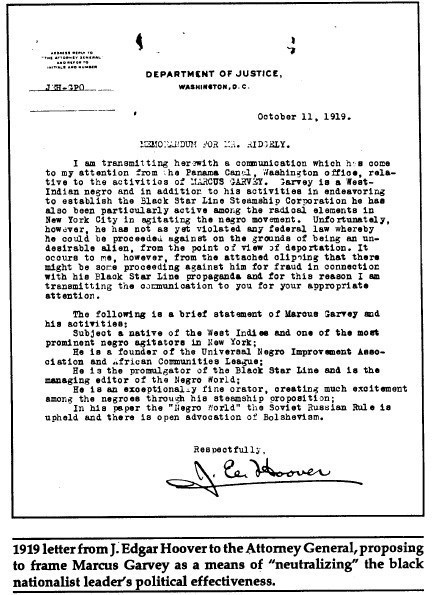
October 1 Elaine, Arkansas 200 African Americans murdered, arrested and tried for conspiracy in the Moore v. Dempsey case.
11 October memorandum from J Edgar Hoover to special agent Ridgely.
14 October Garvey shot by George Tyler, grazed on his temple and caught in the leg. Tyler commits suicide the next day, Tyler was also the only witness for the criminal libel charge against Garvey.
October Garvey speaks at Philadelphia Peoples Church again.
The Negro World seized in British Guiana and Honduras, according to the Saint Vincent Gazette October 1919 anyone bringing the paper into the colony to serve six months prison sentence, possibly with hard labor.
November Second anniversary of the Bolshevik Revolution BOI agents police raid Union of Russian Workers in 12 cities.
Garveys name put forward to Louis F. Post at the Labour Department for deportation on unsubstantiated grounds.
December Du Bois in the Crisis covers lynching in Omana, Nebraska.
December Guianse Edward Green Smith founding member, Secretary UNIA and accountant who previously worked at the ammunition factory in Trenton, New Jersey shot during robbery, pregnant wife dies from shock BSL principal negotiator.
December 25 Garvey marries Amy Ashwood two week honeymoon in Canada Toronto and Montreal.
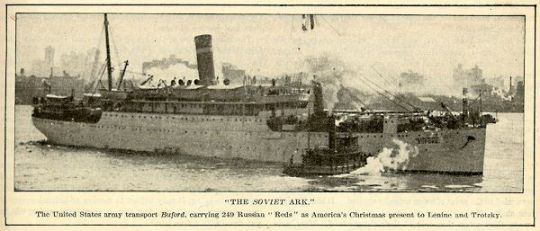
Garveys name put forward to Louis F. Post at the Labour Department for deportation on unsubstantiated grounds.
December 1919 Guianse Edward Green Smith founding member, Secretary UNIA and accountant who previously working at the ammunition factory in Trenton, New Jersey employment shot during robbery pregnant wife dies from shock BSL principal negotiator.

The Belize branch of the Universal African Black Cross Nurses established in 1920 by Vivian Seay.
Seay survey infant and maternal recruits nurse trainees.

Garvey and Green without Cockburn charter the SS Frederick Douglas at the rate of $11, 000 as opposed to $100, 000 with repairs amounting to $11, 000 and fail to include limited indemnity clause in contract with Green River Distillery making them liable damages to whisky company prohibition deadline 16th January confiscated.
Cockburn receives $2,000 commission from Green River Distillery to load the and sail the ship.
1920 January 15 Frederick Douglas sails from the U. S. to Havana, Cuba with 20, 000 cases of whiskey, 500 cases of champagne and 350 barrels of wine 500 cases of whisky, caught in storm off the coast of Cape May, the cargo shifts in its Hull making its starboard list heavy, tossed aboard in order to prevent it from capsizing and has to be towed back to New York .
neglect to making docking arrangements cargo cant be unloaded because of the shoremans strike, left to face penalty of thousands every day for 32 days.
Chief Officer Hugh Mulzac and UNIA delgation meet arrive at Havana, Cuba meet President Menocal and are given banquet at his palace.
The SS Frederick Douglass at Colon Panama carries 500 Caribbean laborers to Cuba.
The SS Frederick Douglass makes a ceremonial stop at Bocas del Toro in Costa Rica.
In Kingston, Jamaica the SS Frederick Douglass cargo of 700 tons of coconuts which rot on detour to Boston.
Du Bois publishes the first of his three autobiographies Darkwater: Voices From Within the Veil containing his “The Damnation of Women” essay as well as The Brownies Book, a monthly children’s magazine co founded by Augustus Granvil Dill and Jesse RedmonFauset.
1920 Du Bois publishes the first of his three autobiographies Darkwater: Voices From Within the Veil containing his "The Damnation of Women" essay as well as The Brownies Book, a monthly children's magazine.

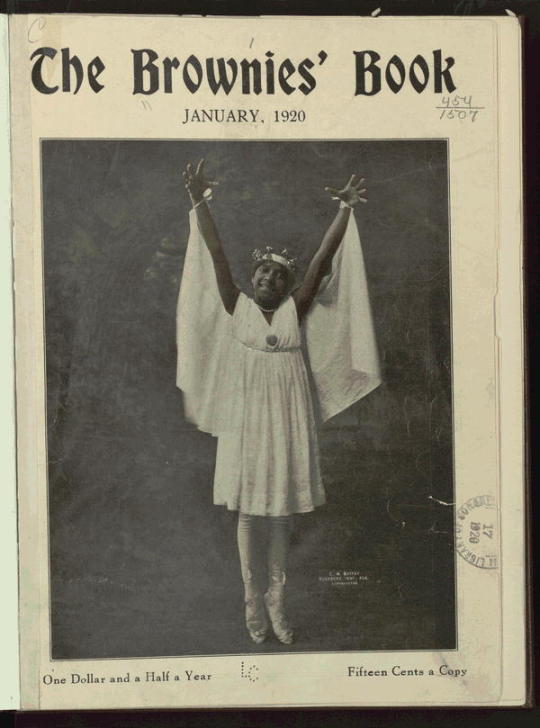
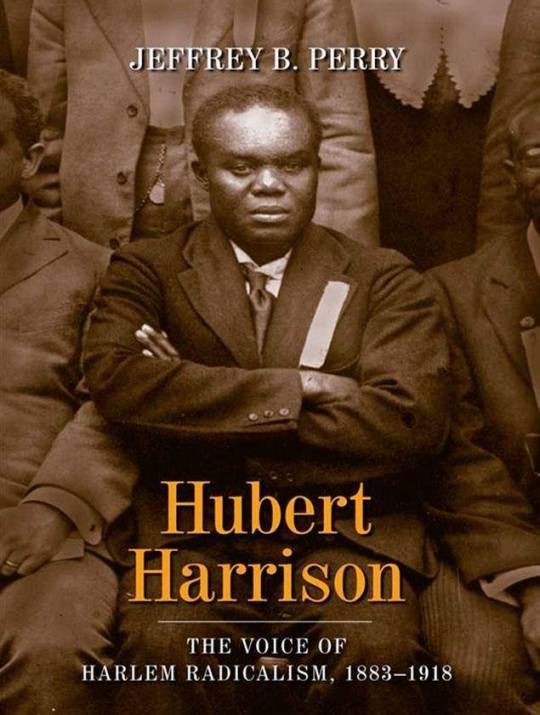
January Harrison becomes editor of the Negro World and also contributes to the Declaration of Rights of Negro People’s of the World.
August the first UNIA Convention was held for the whole duration of the month of August in Madison Square Gardens, New York City. It was at this convention that the Bill of Rights the Declaration of Rights of the Negro Peoples of the World was drafted and adopted. https://tmblr.co/Z9elId2ORVqcw

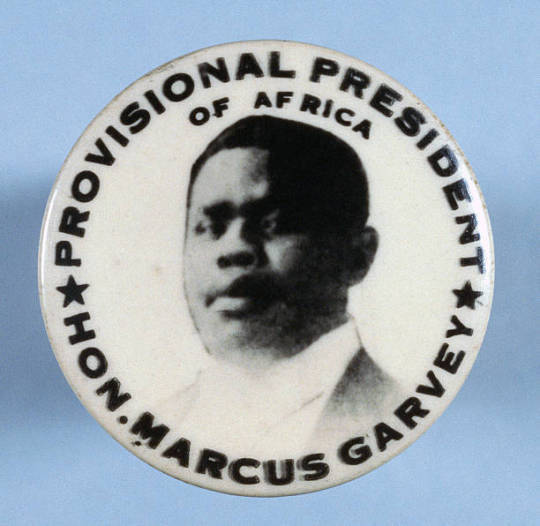
It was at this event where he was duly elected Provisional President of Africa at the convention Garvey reportedly read two telegrams one from Irish Republic leader Eamon de Valera Provisional President of Ireland and the other from Zionist in Califonia Louis Michael.
Are ye not as children of the Ethiopians unto me, O children of Israel? saith the LORD. Have not I brought up Israel out of the land of Egypt? and the Philistines from Caphtor, and the Syrians from Kir? Amos 9:7

10. We protest against segregated districts, separate public conveyances, industrial discrimination, lynchings and limitations of political privileges of any Negro citizen in any part of the world on account of race, color or creed, and will exert our full influence and power against all such.
12. Against all such inhuman, unchristian and uncivilized treatment we here and now emphatically protest, and invoke the condemnation of all mankind.
17. Whereas the lynching, by burning, hanging or any other means, of human beings is a barbarous practice and a shame and disgrace to civilization, we therefore declare any country guilty of such atrocities outside the pale of civilization.

24. We believe in the doctrine of the freedom of the press, and we therefore emphatically protest against the suppression of Negro newspapers and periodicals in various parts of the world, and call upon Negroes everywhere to employ all available means to prevent such suppression.
25. We further demand free speech universally for all men.
33. We vigorously protest against the increasingly unfair and unjust treatment accorded Negro travelers on land and sea by the agents and employee of railroad and steamship companies, and insist that for equal fare we receive equal privileges with travelers of other races.
35. That the right of the Negro to travel unmolested throughout the world be not abridged by any person or persons, and all Negroes are called upon to give aid to a fellow Negro when thus molested.

39. That the colors, Red, Black and Green, be the colors of the Negro race.
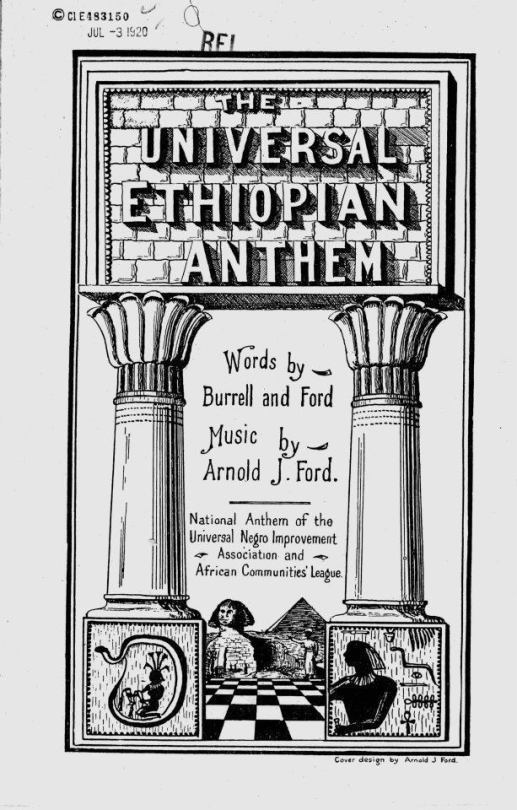
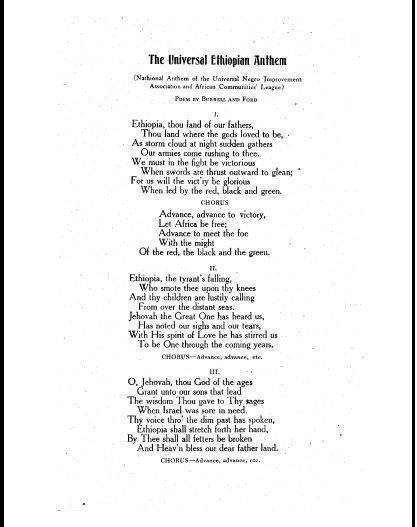

40. Resolved, That the anthem “Ethiopia, Thou Land of Our Fathers etc.,” shall be the anthem of the Negro race… adopted by the RasTafarites Universal Ethiopian Anthem.
Signatories of the Declarations of the Rights of Negro Peoples of the World capture the moment during the 1st International Convention of the Negro Peoples of the World.
Negro World editor William Ferris spots WEB Du Bois at the convention.
18 January Negro World SS Kanawah Antonio Maceo to sail for Bermuda, Cuba, Haiti, Jamaica, Panama. Sir Willocks governor general British Secretary of State for the Colonies Winston Churchill prohibit landing.
Advert Negro World Architects and Contracting Builders to sail to Liberia between January 25 February 20.
1921 Haitian Elie Garcia auditor general produce two reports on Liberia.
Son of Liberian President Hilary Johnson, Mayor of the Liberian capital, Monrovia, Gabriel Johnson, UNIA Potentate Leader of the Negro Peoples of the World along with George O Marke, Supreme Deputy Potentate in charge of the Sierra Leone division of the UNIA and accountant and stenographer, Resident Commissar Cyril A Crichlow sent to acquire land and property in Liberia 30 40 miles away from Monrovia farm owned by local Mrs.Moort however land quality.
Johnson previously a Brigader, his brother Attorney General, first cousin was also married to the later President D. B. King.
Edwin Barclay Liberia Secretary of Sate French and British bordering colonies of Sierra Leon and Ivory Coast.
February Garvey tours the West Indies and Central America also with the initiative of raising funds.
Hoover alerts immigration in Florida so that the Labour Department ports refuse his reentry however Hoover could not provide them with grounds.
28th February Garvey Amy Jacques and her younger brother Cleveland take the train to Key West where they board the USS Governor Cobb to Havana, Cuba.
7 March Liberia President Charles D. B. King arrives on the USS Panhandle in New York harbor, UNIA delegation meet hom at Waldorf Astoria Hotel.
Charles Latham American consul in Jamaica instructed to refuse Garvey a visa to Panama as well as a reentry visa into America.
Costa Rica 10, 000 people to see Garvey at Limon according to United Fruit company manger G. P. Chittenden one meeting two scrap baskets and one suitcase full of United States gold notes were collected and at another he stood beside a pile of gold notes which reached above his knees possibly as much as $50, 000.
Garvey introduced to President Julio Acosta in the capital.
Garvey granted visa by Panama visits the cities of Bocas Del Toro and Almirante in Panama although the response he received was not so much of an enthusiastic one but more.
Garvey travels to the city of Colon by submarine where he is greeting by the biggest crowd he has ever seen, they brake the windows of his train carriage and carry him out into a car but there are so many people on top of the car that the tyres puncture and the car has to be pushed.
May 31 June 1 Tulsa, Oklahoma riot Dick Rowland assault elevator in Drexel building, mob jail shots, Greenwood little Africa.
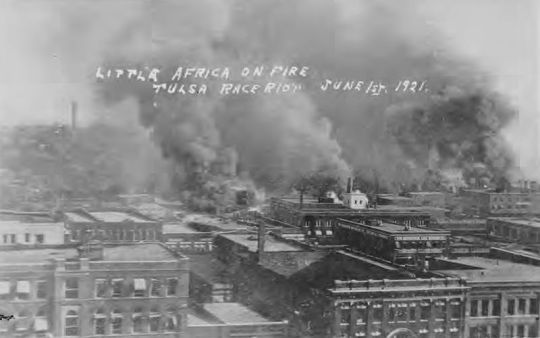
May June Tulsa, Oklahoma riot Dick Rowland assault elevator Drexel building mob jail shots Greenwood little Africa.
25th May the ship the SS Kanawah/Antonio Maceo, sets sail for Panama. boilers three days Kingston.
Garvey denied reentry visa generals voted counsellor general William Matthews sent to Washington to lobby the state department. staff visa control. Garvey advised by lawyer for the American consul to send a cable to state department requesting a visa in which event the visa was granted.
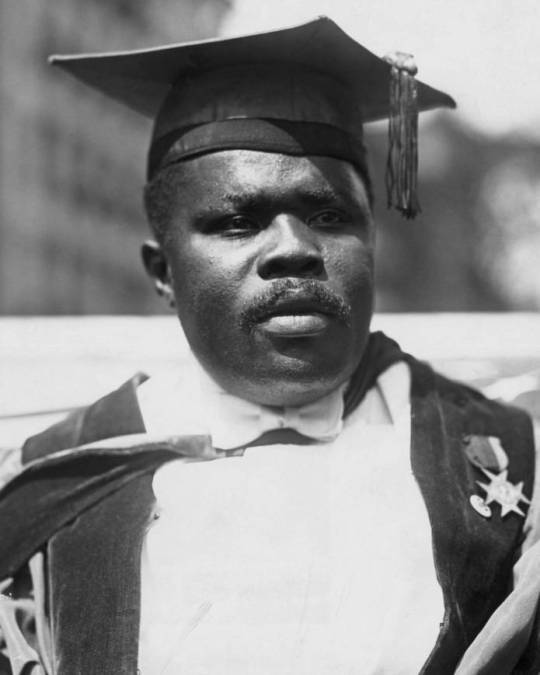
At the annual convention in August 1921 literary editor William Ferris and journalist John E Bruce knighted with order of the Nile, George Tobias with the order of Ethiopia and Henrietta Vinton Davis with Lady Commander of the Sublime order of the Nile.
Marcus Garvey quoted Psalm 68:31 on numerous occasions including in his Christmas message to the Negro Peoples of the World December 1921 as well as in his Emancipation day speech made at Liberty Hall New York city on 1 January 1922. https://tmblr.co/Z9elId2OPQ-fq
1922 January Garvey arrested for mail fraud but bailed for $2, 500, Garvey was brought to charge with mail fraud on the basis that the BSL had advertised the ship the Orion as SS Phyllis Wheatley which they did not yet actually own but were still in the process of negotiation for, Thompson, Garcia and George Tobias were also investigated, however, only Garvey was prosecuted.
May 22 UNIA Commissioner Robert Moseley invited to speak at Baptist church’s, arrested and fined for vagrancy in Jacksonville, Texas and separately also taken to the woods and horsewhipped.
Garvey Los Angeles local division and others parade Oakland California Frisco. Commander J.J. Hannigan San Francisco 400 new members.
May 27 Garvey marries Amy Jaques in Baltimore.
June 25 Garvey travels to Atlanta for a meeting with the Imperial Wizard of the Ku Klux Klan.
Garvey meets with and is interviewed by Hutson on his first visit to Belize 5 July Huton sent transcript of the recorded interview to Secretary of the Colonies the British PM Winston Churchill.
July office Harlem building floor above UNIA Publishing and Printing House the Messenger editorial Chandler Owens and A Philip Randolph William Pickens and Detroit preacher Robert Bagnall Garvey Must Go campaign.
Garvey and Amy picture.
May 27 Garvey marries Amy Jaques in Baltimore.
June 25 Garvey travels to Atlanta for a meeting with the Imperial Wizard of the Ku Klux Klan.
Garvey meets with and is interviewed by Hutson on his first visit to Belize 5 July Huton sent transcript of the recorded interview to Secretary of the Colonies the British PM Winston Churchill.
July office Harlem building floor above UNIA Publishing and Printing House the Messenger editorial Chandler Owens and A Philip Randolph William Pickens Detroit preacher Robert Bagnall.
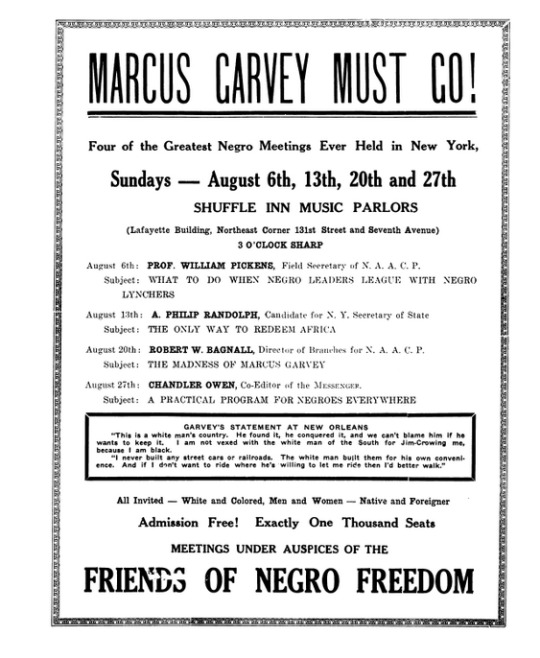
The Messenger. 6.9 (August 1922). William Pickens NAACP Detroit preacher, Robert Bagnall Messenger.
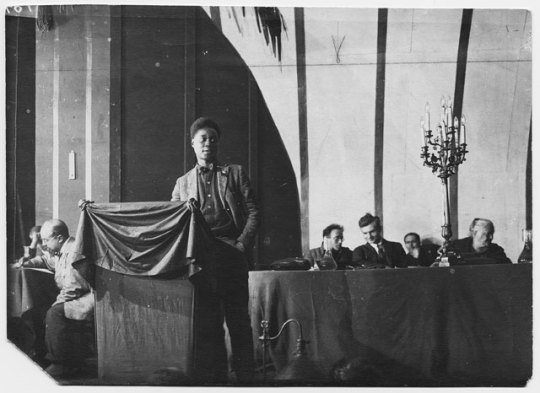
August Trinidadian pilot Hubert Fauntleroy Julian dubbed the Black Eagle of Harlem by H. Allen Smith because of his parachute jumps, flys biplane over UNIA parade and becomes head of the organisation’s new Aeronautical Department.
September 5 Randolph at 2305 7th Avenue receives package calls the police bomb squad open package containing a severed human hand.
November 9th Esau Ramus Philadelphia branch UNIA janitor New Orleans William Phillips.
Reverend Eason Baptist Church, St John 1st Street, shot in the back and forehead, dies from wounds on January 1923. William Shakespeare and Fred Dyer charged with Easons murder. Claude McKay in Kremlin, Russia.
November Max Eastman Fourth Congress of the Communist International Petrograd.

Otto Huiswould and Claude McKay, two leading early members of the Communist International (Comintern). They both addressed the Comintern in Moscow in 1922.
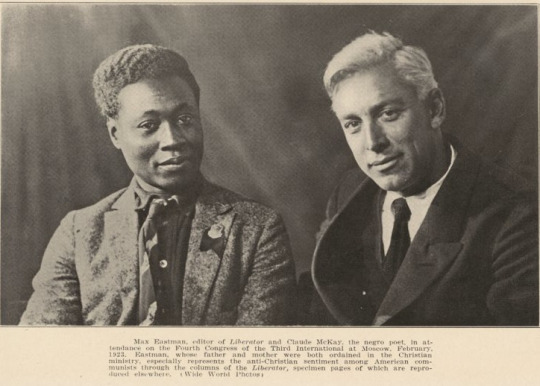

Claude McKay with Arthur Holitscher and Clara Zetkin in Russia - December, 1923.

Claude McKay and International Group in Russia - December, 1923
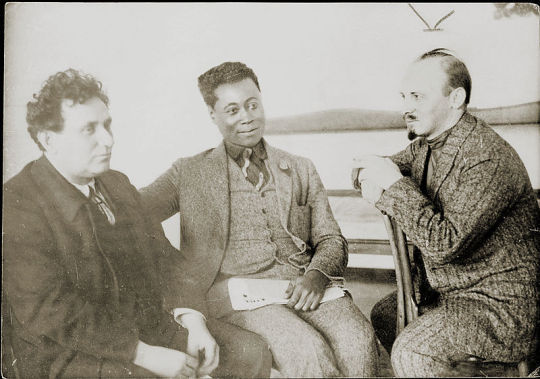
McKay with Grigory Zinoviev and Nikolai Bukharin in 1923.
McKay also meets communist Leon Trotsky.
Philosophy and Opinions of Marcus Garvey by Amy Jaques Garvey 1923 Chapter 3 The Image of God
If the white man has the idea of a white God, let him worship his God as he desires. If the yellow man’s God is of his race let him worship his God as he sees fit. We, as Negroes, have found a new ideal. Whilst our God has no color, yet it is human to see everything through one’s own spectacles, and since the white people have seen their God through white spectacles, we have only now started out (late though it be) to see our God through our own spectacles. The God of Isaac and the God of Jacob let Him exist for the race that believes in the God of Isaac and the God of Jacob. We Negroes believe in the God of Ethiopia, the everlasting God — God the Father, God the Son and God the Holy Ghost, the One God of all ages. That is the God in whom we believe, but we shall worship Him through the spectacles of Ethiopia.
Ras Nasibu Emmanuel Oganden Hindenburg Wall Poem.
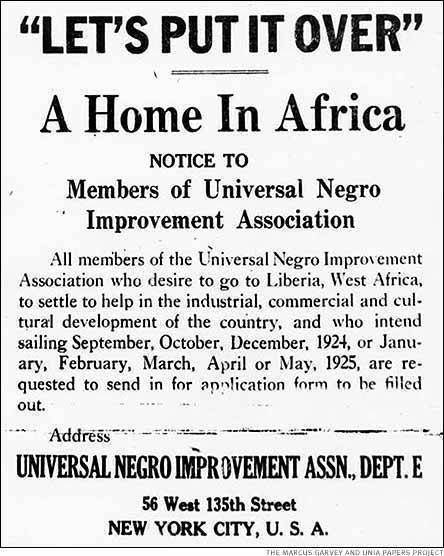
Edwin Barclay Liberias secretary of state French and British bordering colonies of Sierra Leone Ivory Coast disapproval.
Hilary Johnson clerk office Crichlow pulling weight 24 March sent cable ship $5, 000 steamer for sawmill.

1 December UNIA delegation departs for Liberia via Lisbon, Portugal on the Cunard vessel SS Britannia.
1923 December Mc Kay Arthur Holitscher and Clara Zetkin in Russia. International Group in Russia. Grigory Zinoviev and Nikolai Bukharin.
1924 11th February UNIA delegation meets with President 3, 000 immigrants land in three colonies Cavalla, Sino and Grand Bassa as well as in Cape Mount.
16 March Robert Poston fever lobar pneumonia dies on board SS President Grant.
April 19 send material artisan technicians carpenter builder and mechanical engineer.
Seay 24 trained nurses to Belize Town as volunteers parenting teaching, sanitation, midwifery services.
May 19 Du Bois with Professor Wendell Phillips Dabney finally comes face to face with Garvey for the first time at the elevator in Sheraton Hotel, Cincinnati.
11th February meet with President 3, 000 immigrants land in three colonies Cavalla, Sino and Grand Bassa as well as in Cape Mount.
23 June 1923 Garvey sentenced to five years in prison for mail fraud. Garvey spends three months in the Tombs Jail Manhattan detention center and would be bailed for the sum of $15, 000 which was raised in campaign by Amy Jacques by September.

Bishop Alexander Mc Guire the first black archdeacon of the Protestant Episcopal Church ‘We have reasons to believe that his enforced solitude has clarified his vision’ 'Moses came back to Israel with new Revelation’ 'Negro everywhere will be the beneficiaries of the new ideas he has gained during his vacation’.
16 March Robert Poston fever lobar pneumonia dies on board SS President Grant.
April 19 send material artisan technicians carpenter builder and mechanical engineer.
Seay Twenty four trained nurses.
May 19 Du Bois with Professor Wendell Phillips Dabney finally comes face to face with Garvey for the first time at the elevator in Sheraton Hotel, Cincinnati.
June 4 mining engineer Wallace Strange.
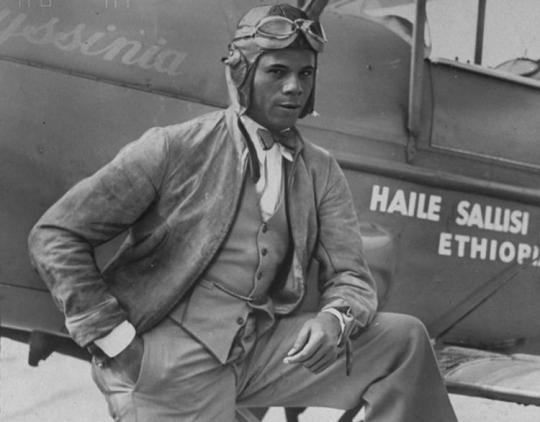
1924 July 4 UNIAS Hubert Fauntleroy Julian to make transatlantic flight from New York to Liberia via Atlantic city, New Jersey and the West Indies. Purchases seaplane christened Ethiopia I, crashes into Flushing Bay after one of the planes pontoons comes off.

Robinson diploma in auto mechanics, Tuskegee civilian pilot training program there Melaku Beyan Ethiopian Army shot in the arm and exposed to mustard gas.
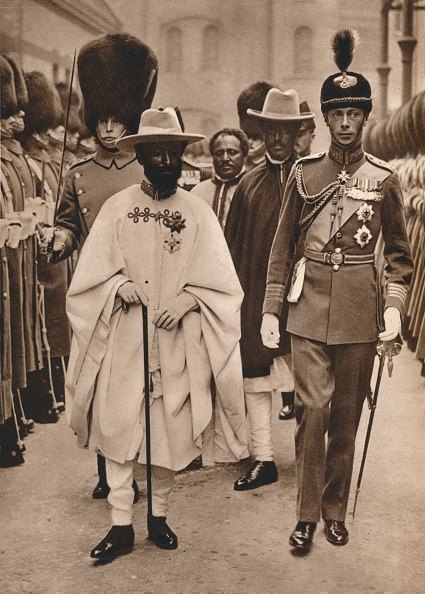


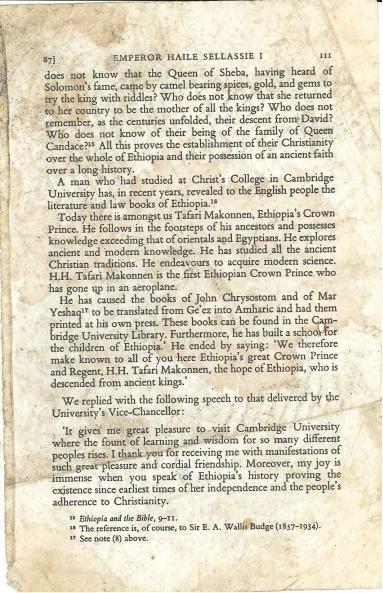
10 July Liberia Consul General in US press release stated that anyone from the UNIA in the US would not be allowed to land in the republic of Liberia the Liberian Consuls in the US instructed not to permit them visas. Wallace Strange Monrovia arrested and deported equipment auctioned Chief Justice J. J. Dossen of Liberia President ports refuse entry. given preference to the Firestone Rubber Plantation Company 1 million acres of land 5 to 10 cents per acre.
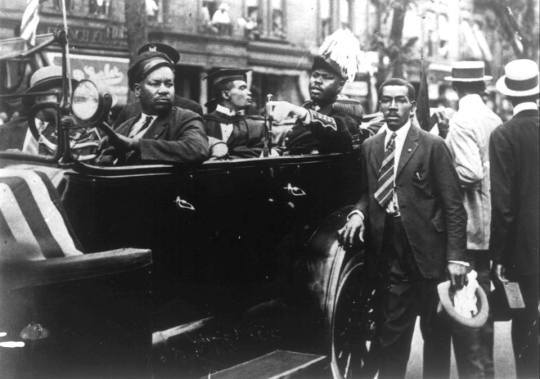
The Most Honorable Marcus Garvey is accompanied in the rear seat of his shiny 1920 Pierce Arrow Limousine by the Rev. R Van Richards at the 4th International Convention of the Negro Peoples of the World Opening Parade in Harlem, NY. His Secret Service (aka Knights of the Roundtable) ran alongside the President-General’s parade vehicle. Although its not visible in this photo, Mr. Garvey is also flanked in the rear by a banner reading Parent Body Division. (Negro World August 16, 1924, p.10)
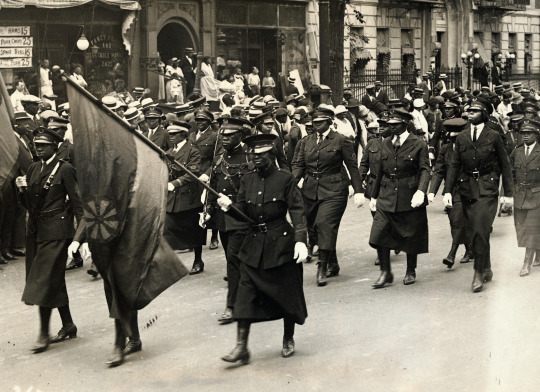
Uniformed Universal African Motor Corp marching up 7th Ave in Harlem, NY during the opening parade of the UNIA sponsored 4th International Convention of the Negro Peoples of the World in 1924.

Universal Motorcorp In Parade - 1924
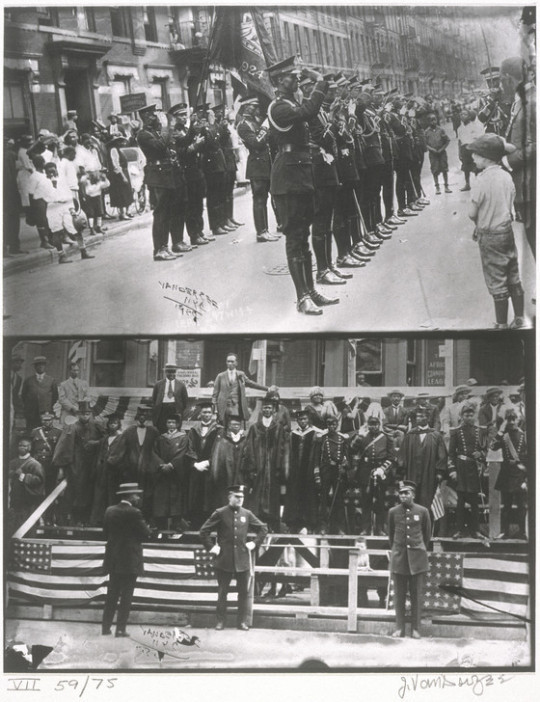
Executive Council Reviews Parade From Observation Deck and Universal African Royal Guard Parade Drill in Harlem, NY.
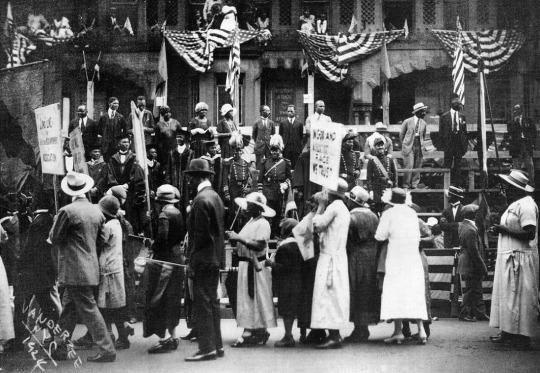
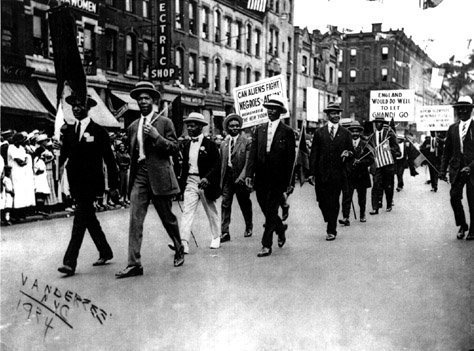
Contingent of the Detroit Division #125 in the opening day parade of the 1924 International Convention of the Negro Peoples of the World, hosted by the UNIA in Harlem, NY. USA. President Joseph A Craigen is seen leading the march with his Red, Black and Green Flag draped over his shoulder.

Dinner Scene at the Third Royal Court Reception of the UNIA at Liberty Hall, NY (Negro World August 30,1924, p.10)

Marucs Garvey in 1924 by James VanDerZee.


Marcus Garvey (right) with George O. Marke (left) and Prince Kojo Tovalu-Houenou. 1924. James VanDerZee (American, 1886-1983). Te Dahomean protonationalist Kojo Tovalou-Houénou declared at the same convention that “your association, Mr. President … is the Zionism of the Black Race.”^ Les Continents, 15 October 1924.

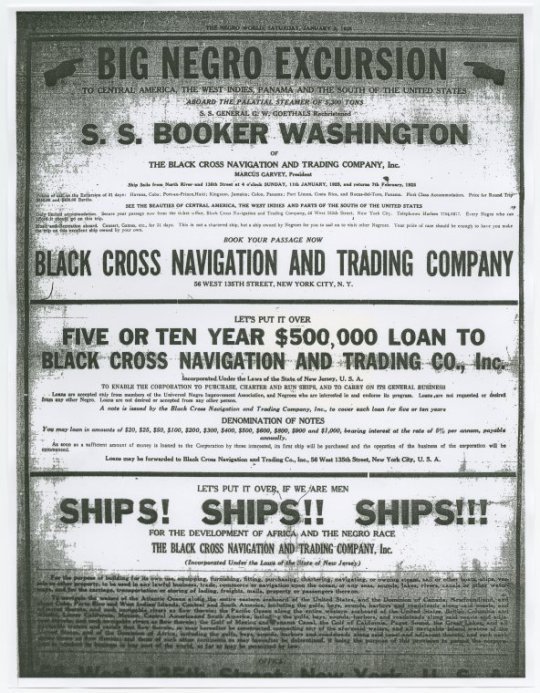
Big Negro Excursion [January 3, 1925, advertisement in the Negro World announcing the sailing of the S.S. Booker T. Washington to Central America, the West Indies, Panama, and the South of the United States.

Amy Jacques Garvey, Henrietta Vinton Davis and Marcus Garvey during the renaming of the ship from the 'General G.W. Goethals’ to the S.S Booker Washington.


Marcus Garvey (center), President General of the African Republic, leaves court handcuffed to a deputy, Marshal Hecht, at left being taken into custody to begin serving his sentence at the Atlanta Federal Penitentiary on 8 February 1925.
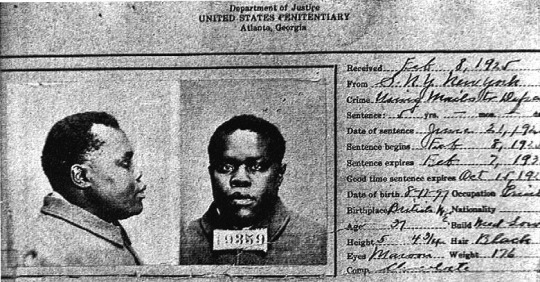
African Fundamentalism
From the editorial by Marcus Garvey orinted in the Negro World, 6 June 1925, as a front-page editorial; written in Atlanta Federal Penitentiary. Original headlines omitted. Creed reprinted in slightly revised form, under the title “African Fundamentalism,” as a UNIA poster, sold by mail order through the Negro World by Amy Jacques Garvey, 1925.
Fellow Men of the Negro Race, Greeting:
The time has come for the Negro to forget and cast behind him his hero worship and adoration of other races, and to start out immediately, to create and emulate heroes of his own.
We must canonize our own saints, create our own martyrs, and elevate to positions of fame and honor black men and women who have made their distinct contributions to our racial history. Sojourner Truth is worthy of the place of sainthood alongside of Joan of Arc; Crispus Attucks and George William Gordon are entitled to the halo of martyrdom with no less glory than that of the martyrs of any other race. Toussaint L'Ouverture’s brilliancy as a soldier and statesman outshone that of a Cromwell, Napoleon and Washington; hence, he is entitled to the highest place as a hero among men. Africa has produced countless numbers of men and women, in war and in peace, whose lustre and bravery outshine that of any other people. Then why not see good and perfection in ourselves?

Marcus Garvey at Atlanta Federal Prison in December 1926.

Garvey was released in November 1927 and boarded in New Orleans to be deported to Jamaica where he arrived at Orrett’s Wharf in Kingston.


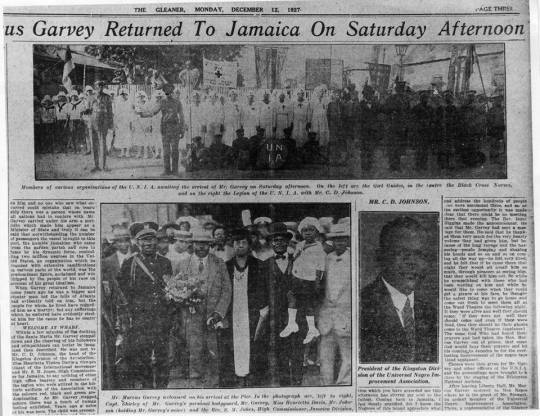
1928 October 7 Ras Tafari Makonnen Crown Prince and Regent Plenipotentiary of Ethiopia is crowned Negus (King) Empress Zawditu daughter of Emperor Menelik II seated to his left.
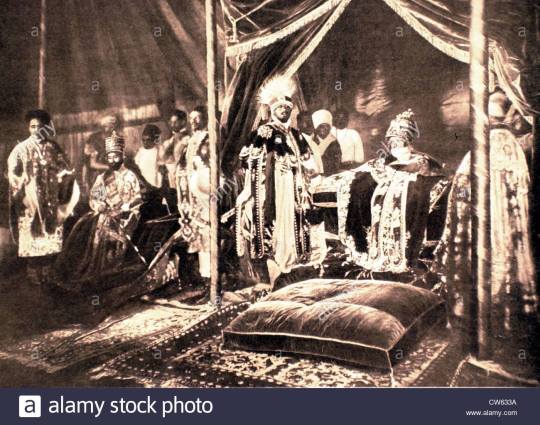
Julian at the Emperor Haile Selassie’s pre coronation show, parachutes landing in front of the Emperor, the Emperor grants him citizenship, the rank of colonel as well as the highest honour in Ethiopia, the order of Menelik.
Julian at the Emperors coronation dress rehearsal crashes the Emperors personal plane de Havilland Gipsy Moth into a Eucalyptus tree, the plane was given to the Emperor as a gift from Selfridge’s department store in London.
18th August 1930 performance of Garveys play Coronation of an African King, King Cudjoe of Sudan.
These shall make war with the Lamb, and the Lamb shall overcome them: for he is Lord of lords, and King of kings: and they that are with him are called, and chosen, and faithful. Revelation 17:14

And I saw heaven opened, and behold, a white horse, and He who sat on it iscalled Faithful and True, and in righteousness He judges and wages war.
His eyes are a flame of fire, and on His head are many diadems; and He has a name written on Him which no one knows except Himself. He is clothed with a robe dipped in blood, and His name is called The Word of God.
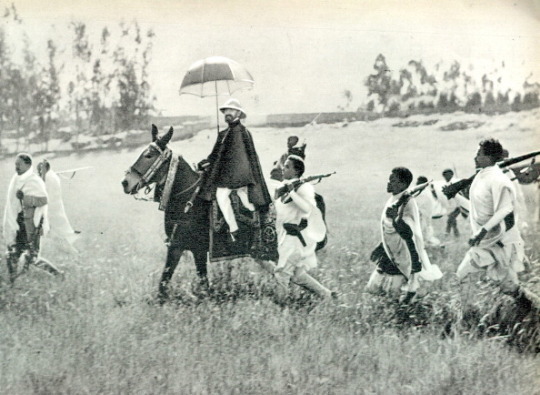
And the armies which are in heaven, clothed in fine linen, white and clean, were following Him on white horses.


November 2 Negus Tafari coronation as Emperor Haile Selassie Time weekly magazine. National Geographic Magazine monthly Volume LIX Number 6 1931 June.
1932 E.A. Wallace Budge publishes his second edition of the Ethiopic Book of the Glory of Kings.
1933 Leonard Percival Howell began to preach about the Ethiopian Emperor Haile Selassie in the parish of Saint Thomas at largely attended meetings accused of ‘Blantant swindle selling pictures at 1s per piece to boost the sale of King RasTafari of Abyssinia son of King Solomon by the Queen of Sheba. Howell held meetings in Trinity Ville and Seaforth of 300 and in 1934 was trailed and sentence for two years sedition and even blasphemy and Robert Hinds ‘his disciple’ led astray by evil doctrine sentenced to one year at the Saint Thomas Circuit Court in Morant Bay by Chief Justice Robert Lyall Grant.
Du Bois resigns at The Crisis to work at Atlanta University.
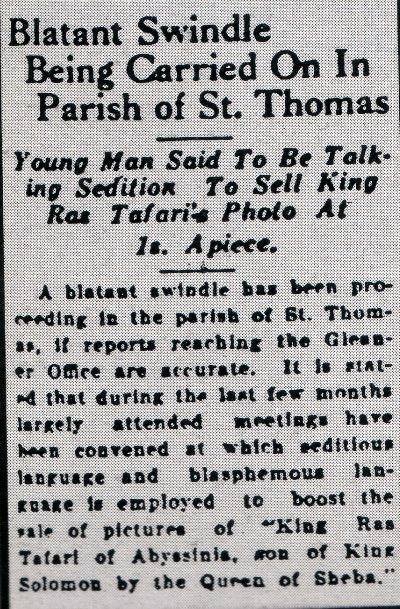
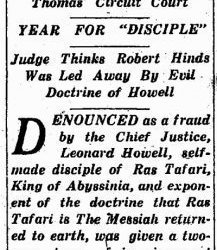
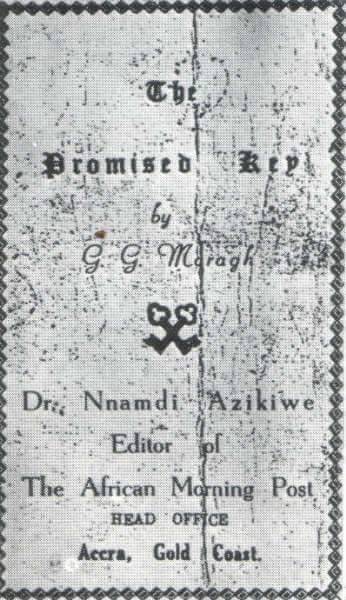
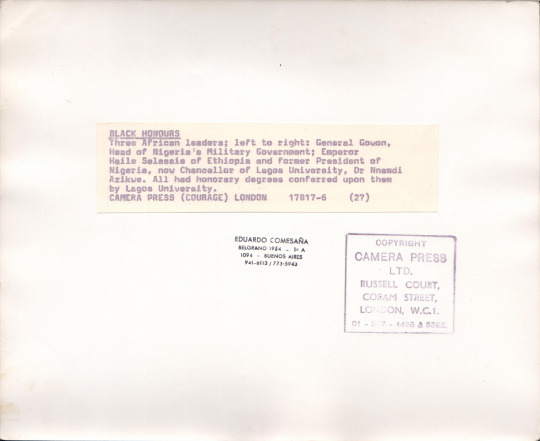

Meanwhile the second ItaloEthiopia war began over the Italo Ethiopia Treaty of 1928 similarly to the first ItaloEthiopia war in 1895.
The Italians built a military post on within the border of Ethiopia in 1930 which caused the WalWal incident in 1934.
The members of the League of Nations especially France and Britain failed to comply with Article X of the covenant and did not act to assist Ethiopia under Italian aggression, they wanted Italy as an ally against Germany, it was Italys plan to make Ethiopia an East African colony along with Eritrea and Italian Somalian.
1935 January Pierre Laval and Benito Mussolini sign the Franco Italian agreement which gave Italy a part of bordering French Somliland (now Djibouti) as part of Eritrea as well as the Aouzou strip in French Chad in Italian Libya.
Du Bois publishes his Black Reconstruction in America.
During the Ethiopian Crisis people from all other the world rallied support for the Emperor including The International African Friends of Ethiopia among whos members included Amy Ashwood Garvey, Jomo Kenyatta, C. L. R. James and George Padmore.
July
August

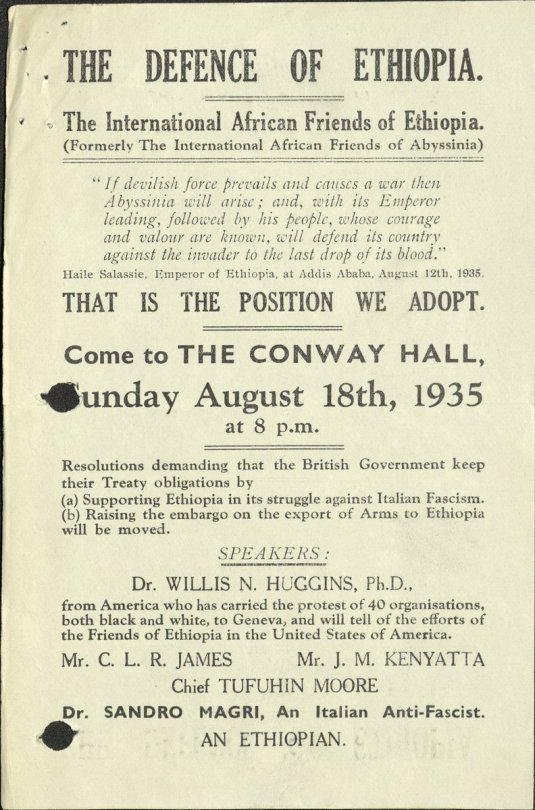

The Honorable Amy Ashwood Garvey speaks before a London crowd at Trafalgar Square, denouncing the Italian invasion of Ethiopia.“No race
has been so noble in forgiving, but now the hour has struck for our complete emancipation. We will not tolerate the invasion of Abyssinia.“
Mrs. Garvey said: "In this struggle, the black women are marching beside the men. You white people brought us out of Africa to Christianize us and civilize us, but all the Christianity and civilization you gave us for 320 years was slavery. You have talked of ‘The White Man’s burden.’ Now we are carrying yours and standing between you and Fascism.”
She warned the British Government that if this became a struggle between the “Blacks” and the “Whites” that three quarters of the people of the Empire are colored.
Jamaica Gleaner, September 11, 1935.
August 12 Ethiopia also pleads for the embargo to be lifted.
October 5 Italian I Corps take Adigrat.
October 6 Italian II take Adwa.
October 15 General Emilio De Bono forces advance from Adwa occupy Axum Bono loots Obelisk.
October Saint Lucia Clarkes Theatre International Friends of Ethiopia Foreign Enlistment Act.
November The League of Nations places sanctions.
December Samuel Hoare Pierre Laval Pact was secretly agreed to sign OgadenTigray and Southern parts of Ethiopia away to Mussolini when this was found out they were forced to resign.
December 30 Red Cross unit at Dolo bombed, Egyptian ambulance at Bulall attacked, Egyptian medical unit at Daggah Bur.
1936 January 12 to 16 Battle of Genale Doria.
January 20 to 24 First Battle of Tembien Ras Kassa Phosgene gas makale.
February 10 to 19 Battle of Amba Bradam Ras Mulugeta.
February 27 to 29 Second Battle of Tembien Ras Kassa and Ras Seyoum.
March Red Cross camp Quoram.
Hitler militarisation of Rhineland.
March Battle of Shire Ras Imru. 969 Italian
March 22 Regia Aeronautica bomb Harar.
March 26 March of Iron Will Dessie to Addis Ababa.
March 31 Battle of May Chew.
Stresa Front.
April 4 mustard gas Lake Ashangi Regia Aeronautica.
April 14 Graziani Ras Nasibu Emmanuel Battle of Ogaden.
May His Imperial Majesty boards the train from Addis Ababa to Djibouti, with the gold of the Ethiopian Central Bank. According to Barker, A. J. (1971). Rape of Ethiopia, 1936. New York: Ballantine Books, Graziani suggested to Mussolini that he have the train bombed which however he didn’t see fit to do so.
The Emperor and hunting party in Ethiopia before the Italian invasion drove him into exile. It was taken on the Addis Ababa to Djibouti railway line in the early 1930s just after he’d been officially crowned as Emperor.
May 4 H.I.M. sails from Djibouti in the British cruiser HMS Enterprise.
May 5 Addis Ababa taken.
May 8 arrives at Haifa.
from Mandatory Palestine sails to Gibraltar on the way to Britain.


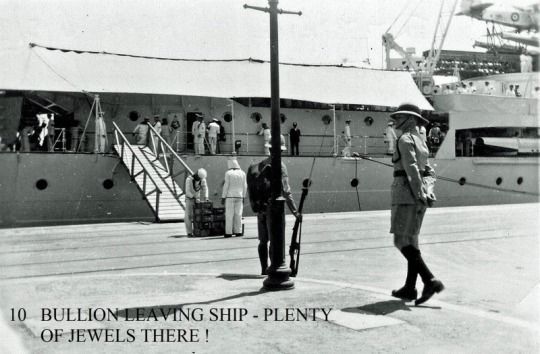




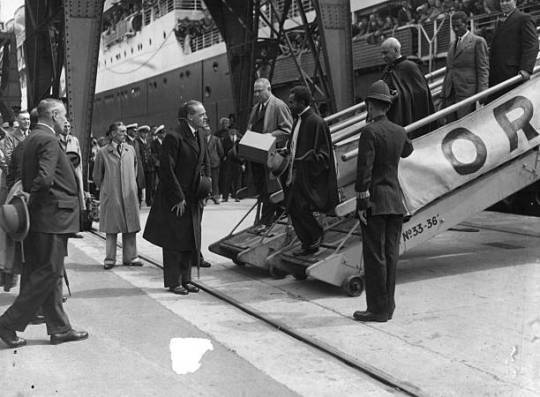
May 5 after the fall of Addis Ababa the sanctions are dropped.
Benito Mussolini also used poison gas and mustard gas which were exposed by International Red Cross.
June 30 The Emperor himself addresses the League of Nations in Geneva, Switzerland.
Howell marries Teneth Bent.
Du bois visits Nazi Germany, China and Japan.
July 4 The League of Nations votes to lift sanctions imposed against Italy.
July 15 Sanctions lifted.
Mussolini and Hilter become allies during the Spanish Civil War, Mussolini declares war on Britain and France attacks British in Egypt Sudan, Kenya, British Somaliland.

1937 the Brotherhood of Sleeping Car Porters and the pullman company enter contract together.
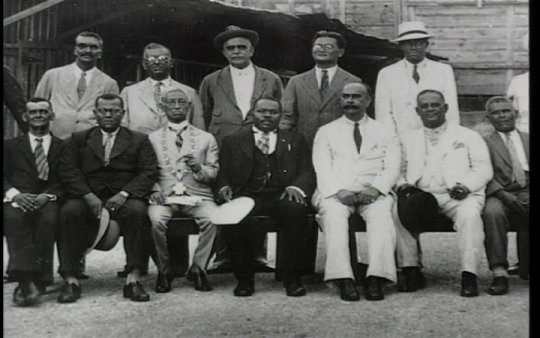
Marcus Garvey (seated in dark suit with fan) and the Port of Spain Trinidad City Council, 1937. Mayor Alfred Richards is to Mr. Garvey’s right.
Tubal Uriah Buzz Butler strike policeman set alight and died colleagues riots. George Padmore International African Service Bureau C. L. R. James author of The Black Jacobins
1938 January strike for higher wages at Serge Island in the parish of Saint Thomas 1, 400 workers, armed 24 injured, 60 arrested.
April 29 Westmoreland strike 4 killed, 13 injured and 105 arrested.
May 23 Kingston strike.
Howell sent to Bellevue Asylum.
1939 April Howell founds the Ethiopian Salvation Society and purchases 485 acres in the hills of Saint Catherine, 5 miles on the road to Sligoville, the free community founded by English Reverend Baptist Minister James Mursell Phillippo in 1843, named after the 2nd Marquess of Sligo, Governor of Jamaica, Saint Catherine also being the parish with the most number of active sugar plantations at the time Howell established this settlement which became to be known as Pinnacle.
1941 July 14 Pinnacle raided for first time 72 arrested.
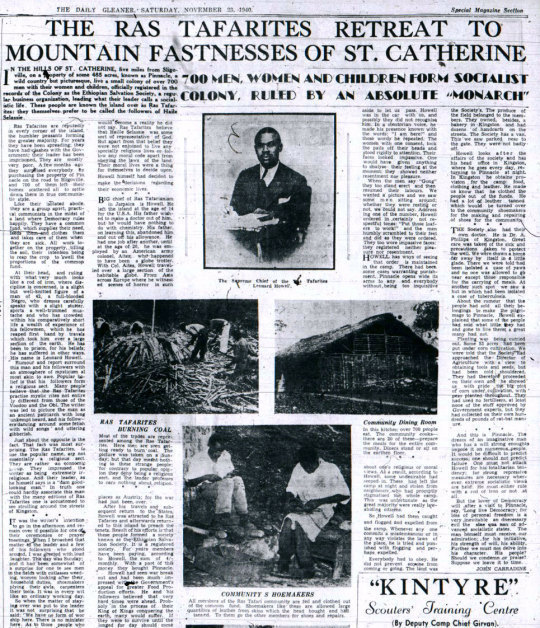
Randolph Madison Square Gardens.
July 24 Howell arrested sentenced to 2 years released 1943 April.
December 23 Howells Wife Teneth Bent Howell dies, Howell accused of murdering her and arrested but is acquitted 1944 April 6.
1948 Ganja Dangerous Drugs Act began to be used against Rastafarite.
1948 January 8 Howell 6 months in prison.
1950 Randolph, Roy Wilkins, Executive Secretary of the NAACP, and, Arnold Aronson, of the National Jewish Community Relations Advisory Council found the Leadership Conference on Civil Rights (LCCR).
1951 January 18 Howell sentenced to 2 year in prison for Ganja.
1954 April Howell arrested for illegal practice of medicine. May two of Howells adolescent sons arrested under false pretense. May 27 biggest Ganja raid as of that time £3, 000 seized.
1957 Randolph Prayer Pilgrimage for Freedom with Martin Luther King Jr.

1958 Pinnacle burnt by Police members disburse.
Randolph Youth Marches for Integrated Schools in Washington, DC.
1960 Howell arrested for Ganja Tredegar Park and sent to Bellevue.

1961 21 April Bob Marleys teacher Nyahbinghi elder Mortimer Planno visits Ethiopia meets His Imperial Majesty Emperor Haile Selassie, April 26 visits Nigeria meets NnamdiAzikiwe, May 10 visits Ghana meets Kwame Nkrumah, May 16 visits Liberia and May 21 visit Sierra Leone meets I.T.A. Wallace.
12th April 1963 Bad Friday Coral Gardens Massacre.

May 25th the Organisation of African Unity was formed with the Emperor Haile Selassie as its chairman and its headquarters in Ethiopias capital Addis Ababa.

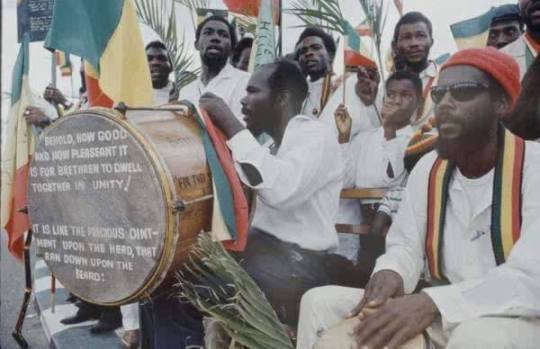

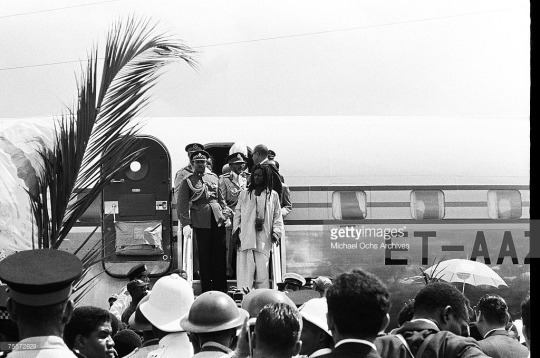
1966 April 22nd Groundation day Haile Selassie Jamaica visit H.I.M. with
Mortimer Planno.
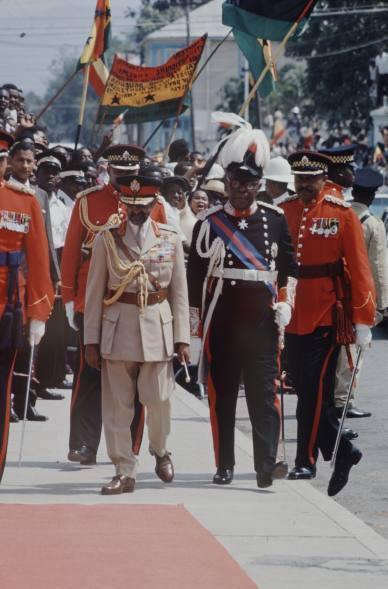


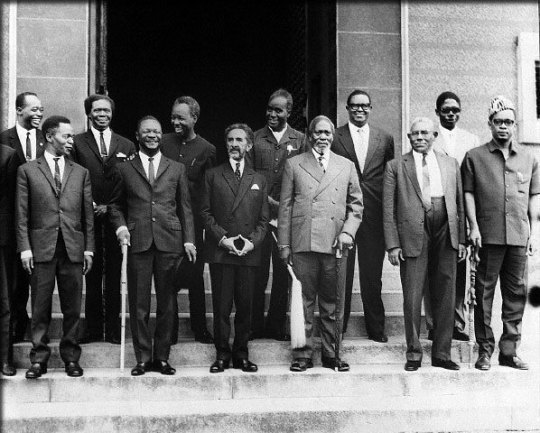
December 22, 1967 Kampala, Uganda- The heads of state and the leaders of governments of East and Central Africa are pictured prior to the opening of their summit conference. Standing in the front row are (L-R): Mr.Kayibanda, President of Rwanda; Mr. Jean B. Bokassa, President of the Central African Republic; Emperor Haile Selassie of Ethiopia; Dr.Jomo Kenyatta, President of Kenya; Mr. El Azhari, President of the Sudan; and Lieutenant General Joseph Mobutu, President of the Republic of the Congo.
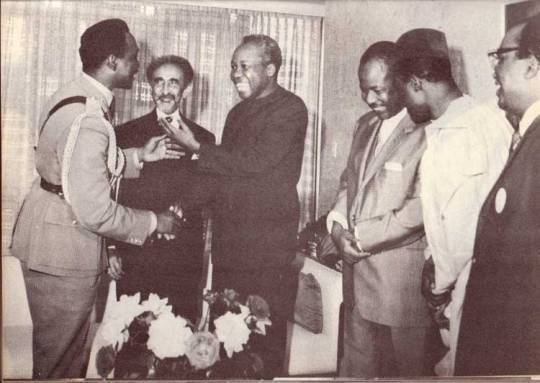
Nigeria & Tanzania reconciled at Africa Hall.

Mediating between Senegal & Guineain Monrovia, Liberia.

Settling differences in the internal crisis in the Sudan.
1978 March arrested for Ganja.
1979 Gunmen terrorize Rastafarites at Pinnacle.

1980 April 18th Bob Marley performs his Zimbabwe song in Zimbabwe at the Independence celebration in Rufaro Stadium Harare.

1986 July 14th - 27th Ras Boanerges Rastafari Focus Conference at the Commonwealth Institute in London.
6 notes
·
View notes
Text
(LAUNCH) An Orca is Way Too Big to Attach, Unless as a JPEG, by Anna Danielewicz

Hey there, it’s summer - come get wavy! Join us at Glasgow’s Category Is bookshop to celebrate the launch of Anna Danielewicz’s new pamphlet, An Orca is Way Too Big to Attach, Unless as a JPEG – sizzling seafoam fresh from SPAM Press!
We’ll be kicking things off with readings from three exciting poets:
🐬 Anthony Daly
🐬 Felicity Anderson-Nathan .
🐬 Gloria Dawson
Followed by a reading by Anna herself.
Combining laconic loops and turns of millennial humour with bursts of minor devastation and sincerity, An Orca is Way Too Big to Attach, Unless as a JPEG records the everyday blisses and horrors of life in the present moment. While Danielewicz’s lines often capture the insouciant cool of Chelsea Minnis or the comic transcendence of Hera Lindsay Bird, you sense she’s as indebted to the lustrous arcades of seapunk, cereal packaging and WikiHow articles as she is to, say, a battered copy of post-internet anthology of I Love Roses When They’re Past Their Best. There’s a soothing, oddly spiritual quality to An Orca is Way Too Big that makes you want to lie in a turquoise pool and count all the pixels in your iPhone to sleep. Nature and technology coexist in moments of occasional chiastic sublime (‘the sun was data transmitting’), and the ‘I’ is a kaleidoscope of cravings, rituals and observational tendencies; turning a page is genuinely like clicking refresh or adjusting the brightness of your screen. Lyric poems are interspersed with original illustrations, which take the familiar aesthetics of Instagram poetry into the khoratic space of the starburst or gradient, the spidery title. Exploring the existential dislocations of material culture alongside the invasive, affective recursions of pop relics (‘found it in a hopeless place, / did we, did we fuck’), An Orca Is Way too Big does the light work of a jpeg compression while keeping in mind the charismatic megafauna of its subjects. Like Walter Benjamin in avatar drag or Crispin Best stubbing his toe on Snapchat bathos, Anna Danielewicz might just be your favourite new flaneuse for Web 2.0. You’re all gonna want to get orca tattoos now.
~
Anna Danielewicz (born in Poland, 1991) is an artist based in Glasgow. She graduated from Edinburgh College of Art in 2016. Her most recent projects include Autocue at Intermedia Gallery, CCA Glasgow and Save the Death Star at the Edinburgh Sculpture Workshop. She is currently working on a piece for the Edinburgh Art Festival and the Present Futures festival. Anna is a member of the programming committee of Market Gallery. Like many other people, in her heart of hearts she would rather be a whale.
http://annadanielewicz.com/
The event is FREE, starts at 7 and finishes at 9. There will be cake, and also plenty of recent SPAM publications and merch for sale.
Some of us are heading to The Glad Café afterwards to celebrate with our friends at GoldFlakePaint, who just launched their third issue – feel free to join.
Please contact the lovely folks at Category Is if you have any queries re: accessibility etc :)
0 notes
Text
The Myth of the Archive of Everything
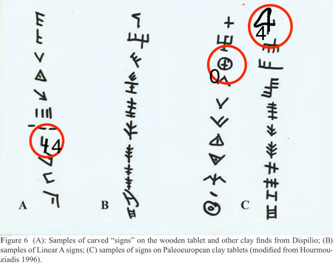
"The Web was not designed to be preserved," says Brewster Kahle, founder of the Internet Archive, a non-profit library of millions of free books, film, software, music, websites and more. "The average life of a Web page is about 100 days," he adds. Kahle is currently on the lookout for an old optical disc drive containing a copy the first ever webpage. It was lost at a conference in California in 1990. Around about the same time, the archaeologist George Xourmouziadis was digging at the site of a Neolithic lake settlement in Northern Greece. In 1993, he found the earliest known example of written text in the world, the Dispillio tablet, a chunk of inscribed wood that had lay buried in the mud for 7,500 years.
The tablet, however, in the absence of some sort of Rosetta stone, is indecipherable. In a way, it is like one of those old floppy discs you might find at the back of a drawer or in a box you stored at your dad’s if you went to university in the late 90s. It’s a strange yet familiar object, and you know it contains information, but you have no way of accessing it, of reading it. Of course, whilst it has taken many thousands of years for the text on the Dispillio tablet to become unreadable, my dissertation hasn’t even made it twenty years, unless I had access to what would by now be pretty specialist equipment.

“He went a long journey, was weary, worn out with labour, and returning engraved on a stone the whole story.”
So goes the world’s oldest known written story, the “Epic of Gilgamesh”, fragments of which have been dated to 2000 BCE. Perhaps other weary travellers returned home and told their story to a friend, which may seem less durable than stone. And yet, research has shown that some Pawnee stories document events that took place during the last glaciation, at least 11,000 years ago, and linguists and geographers have proven that Aboriginal Australians have stories that contain accurate oral histories stretching back 400 generations to over 10,000 years ago. It is therefore important to listen for stories that cannot be physically held in our hands, but that survive nonetheless, perhaps by virtue of the fact they can’t become buried in mud or lost at the back of a drawer. However, these stories do not survive by accident. Oral history keepers are not just saying whatever comes into their head. In Aboriginal Australian communities, for example, complex system of inter-generational kin-based responsibility and cross-checking of stories ensures they are retold and retold verbatim, much in the same way that a Babylonian scribe had to be trained to accurately write the complex cuneiform script.
But in ancient Babylonia, even if a scribe transcribed a text accurately, decisions made by archivists could still render a document unstable. Texts deemed important by the ruling class, such as legal documents, were recorded on clay tablets, while even more ‘important’ texts, such as royal decrees, were written on stone or precious metal. Meanwhile, the Babylonian language and the cuneiform script were generally used for stone or clay inscriptions, whereas Aramaic texts, used in day-to-day trade throughout the region, tended to be written on more perishable material such as parchment and leather. How documents were stored—in jars, boxes or bags or within stone temples, or on specially designed shelves within a royal compound, for example—also affected their longevity. However, even once-important clay tablets were often eventually disposed of, being written over or recycled into floor filling when they were deemed to be no longer of use. In fact, it is thought that many of the texts that survive to this day do so only because they were hidden in times of war by owners unable to ever return to them, grow bored of them, and use them as filler in the foundations of their new extension…
They say that the most important years of a person’s life are their first three years, during which time the very foundation of our being is formed; and yet during that time we are almost universally illiterate. What do babies dream about? What stories do they tell themselves? My six-year-old son is learning to read. “What does that say?” he asks, pointing to an advert for an investment bank. “See More, Be More,” I tell him, and then we unpick the meaning of the text in great detail until we get to Govan. I feel suddenly sad at his new desire to discover the world through text when only 4 years ago he felt it out with tongue and spit, took it into his mouth or fingered it greedily. Of course there are limits to what you can understand in this way, and so language; and there is something particular about written language, even in the way it reaches for a sort of representative neutrality which, of course, it can never contain.
This seeming neutrality is no more evident than on the internet, where we are presented with never-ending feeds of black text on white screens that seem to issue more from the ether than from any mouth. Web content is now overwhelmingly created by non-professionals—by people who go on a journey and returning, weary, worn out with labour, blog about it, tweet about it, write an email to their mother about it, post it on Facebook or Insta. Would they had chiselled it in stone! Because even though these stories and ideas, these projects and diaries, these poems and love letters appear on a screen and have the potential, indeed, to appear on any screen throughout the world, that doesn’t mean they are safely archived. As Jason Scott, an archivist and historian at the Internet Archive says of web-based material: “when it goes, it really goes[…] there is just zero recourse.”
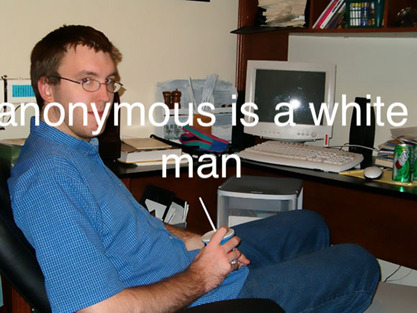
Then there are the silences. In order to archive, an archivist must have material to work with. Yet 45% of the world has no internet access. And whereas in the past, anonymous was a woman, now they are more likely to be a middle-class, white Western man. The seemingly neutral black text on your screen that appears to have been almost communally created by a hive mentality, representative of everyone, leading some to argue that the internet is a platform that can break down barriers to communication, challenging, say, the classed and gendered world of publishing, the facts of the matter say otherwise. A recent American study showed that there are far fewer female bloggers, hackers and Wikipedia editors than there are male ones. Wiki is one of the most used websites in the world and often the first place people go for information, and yet in America only 25% of editors are female, and globally the figure drops to 20%. Women use the Internet much less than men too: globally 12% less, but in places like Africa, 25% less. Men publish more tutorials, podcasts comments and reviews than women and launch more petitions. Only 11% of open-source programmers are female. Class, race and nationality intersect to make these figures far starker in countries such as Palestine, Turkey or Brunei.[1]
The barriers to women’s online participation are multiple and include lower incomes as well as lower literacy and computer-literacy levels globally. Online discrimination, hate speech and harassment also makes it harder for women to participate, with a recent study showing more than 50% of women have received unsolicited offensive images. Much like in the world of paper journalism, online comments regarding female-generated content tends to focus less on the facts of the matter and more of the physical appearance of the women concerned. The Guardian reported that “articles written by women attract more abuse and dismissive trolling than those written by men, regardless of what the article is about.”

People of colour also face increased levels of harassment online. As Hannah Pool, a British-Eritrean journalist and blogger, commented, “I could post my shopping list and I’m pretty sure the thread beneath would include some variants of “go back to Africa”. Two recent studies looking at reactions to similar comments on race by both black and white authors showed that black authors faced significantly higher levels of negative reactions than white ones.[1] Another report showed that British Muslim women faced high levels of online trolling for wearing hijabs or other religious garments. In his book, Convergence culture: Where old and new media collide, Henry Jenkins states that online content creators are, ‘‘disproportionately white, male, middle-class and college-educated’’.
But we shouldn’t be surprised. After all, there has only been a digital revolution, rather than the cultural, philosophical, political and economic revolution that would bring genuine change. The biggest lie we are sold is that technology in and of itself can free us—that it is in the process of liberating us and of breaking down class, gender and racial inequalities. Meanwhile, Google promises us the ‘archive of everything’, insisting that if they develop the technology to capture and archive all digital content, alongside projects to digitise print books en-masse, they will have created an archive of the whole wide world. We must then question what is meant by ‘everything’, who is archiving it, and why. For even if issues of production were addressed, and we all became content providers, and even if Google managed to capture all of that content, and record every single story ever told, from the first to the last, someone or something still has to guide us to that content, sift through it, present it to us. As Walter Benjamin pointed out:
“Perhaps the most deeply hidden motive of the person who collects can be described this way: “he [sic] takes up the struggle against dispersion [Zerstreuung]. Right from the start, the great collecter is struck by the confusion, by the scatter [Zerstreutheit] in which the things in the world are found.”
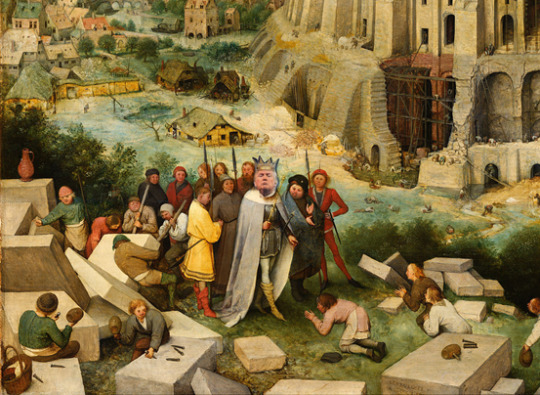
The archive is therefore more about ordering than hoarding. Yet the archive of everything pretends to an objectivity that does not exist. It pretends that in collecting everything it makes everything available, or potentially available, and even that it records our history and culture in a fair and objective manner. It masks the politics of production on multiple levels: the production of knowledge (culture, education, language), of content (writers, speakers, listeners, readers), and of consumption (algorithms, advertising, canons).
For the world already contains ‘everything’, and this ‘everything’ is continually archived through language and stories, culture and memory, networks and systems, and currently, overwhelmingly, this ordering is filtered through process of valourisation in a world dominated by capitalism. We must therefore see every attempt to collect and order as a political act, one that is intricately tied up with power struggles: how do you produce, record and represent the history of a nation, a people, a language, a culture, a world, in an archive?
As people and institutions large and small—from the government and the BBC to your local labour history group; from Google, to your 15-year-old daughter—grapple with the Babelian project of how to capture everything, there is a further shift from a focus on (intellectual) production to that of consumption. And this shift imagines that archivists are now involved merely in a technical project of trying to collect the whole wide world, risking subsuming the politics of the archive, and the space therein for resistance, to the illusion of a totalising objectivity. It is only by re-politicising the productive function of the archive—its capacity to generate culture, ideas and history—that we can show that the archive of everything is nothing more than a myth about how stories are told, and about how they are remembered, or forgotten.
[1] https://www.psychologytoday.com/gb/blog/media-spotlight/201703/race-and-the-internet
[2] https://www.alumniportal-deutschland.org/en/global-goals/sdg-05-gender-equality/women-internet-digital-gap/ [accessed 19/02/19]
0 notes